 Journal of Modern Physics, 2012, 3, 1918-1944 http://dx.doi.org/10.4236/jmp.2012.312242 Published Online December 2012 (http://www.SciRP.org/journal/jmp) Imprints on CMB Angular Power Spectrum Modes from Cosmological Reionization Tiziana Trombetti1,2, Carlo Burigana1,3 1Istituto di Astrofisica Spaziale e Fisica Cosmica di Bologna, Bologna, Italy 2Dipartimento di Fisica, Università La Sapienza, Roma, Italy 3Dipartimento di Fisica e Scienze della Terra, Università degli Studi di Ferrara, Ferrara, Italy Email: trombetti@iasfbo.inaf.it, burigana@iasfbo.inaf.it Received September 11, 2012; revised October 15, 2012; accepted October 27, 2012 ABSTRACT The accurate understanding of the ionization history of the Universe plays a fundamental role in modern cosmology. It includes a phase of cosmological reionization after the standard recombination epoch, possibly associated to the early stages of structure and star formation. While the simple “ -parametrization” of the reionization process and, in par- ticular, of its imprints on the Cosmic Microwave Background (CMB) anisotropy likely represents a sufficiently accurate modelling for the interpretation of current CMB data, a great attention has been recently posed on the accurate compu- tation of the reionization signatures in the CMB for a large variety of astrophysical scenarios and physical processes. The amplitude and shape of the B-mode Angular Power Spectrum (APS) depends, in particular, on the tensortoscalar ratio, r, related to the energy scale of inflation, and on the reionization history, thus an accurate modeling of the reioni- zation process will have implications for the precise determination of r or to set more precise constraints on it through the joint analysis of E and B-mode polarization data available in the next future and from a mission of next generation. In this work we review some classes of astrophysical and phenomenological reionization histories, beyond the simple -parametrization, a present a careful characterization of the imprints introduced in all the CMB APS modes. We have implemented a modified version of CAMB, the Cosmological Boltzmann code for computing the CMB anisotropy APS, to introduce the predicted hydrogen and helium ionization fractions. We compared the results obtained for these models for all the non-vanishing (in the assumed scenarios) modes of the CMB APS. Considering also the limitation from po- tential residuals of astrophysical foregrounds, we discussed the capability of next data to disentangle between different reionization scenarios in a wide range of tensor-to-scalar ratios. Keywords: Cosmic Microwave Background Radiation: CMBR Polarization; Reionization; Gravitational Waves; CMBR Polarization 1. Introduction The accurate understanding of the ionization history of the Universe plays a fundamental role in modern cos- mology. The classical theory of hydrogen recombination for pure baryonic cosmological models [1,2] has been subsequently extended to non-baryonic dark matter mod- els [3-5] and recently accurately updated to include also helium recombination in the current cosmological sce- nario (see e.g. [6] and references therein). Various mod- els of the subsequent Universe ionization history have been considered to take into account additional sources of photon and energy production, possibly associated to the early stages of structure and star formation, able to significantly increase the free electron fraction, e logical reionization phase may leave imprints in the CMB providing a crucial “integrated” information on the so-called dark and dawn ages, i.e. the epochs before or at the beginning the formation of first cosmological structures. For this reason, among the extraordinary results achieved by the WMAP mission1, the contribution to the under- standing of the cosmological reionization process has received a great attention. This work is aimed at a careful characterization of the imprints introduced in the polarization anisotropy, with particular attention to the B-modes. The amplitude of the B-mode APS, whose detection represents a crucial in- direct probe of the stochastic field of primordial gravity waves (see e.g. [7,8]; see also [9-11]), crucially depends on the ratio of the amplitudes of primordial tensor and scalar perturbations , above the residual fraction after the standard recombination epoch at rec. These photon and energy production processes associated to the cosmo- 3 10 3 10z rTS, related to the energy scale 1http://lambda.gsfc.nasa.gov/product/map/current/. C opyright © 2012 SciRes. JMP 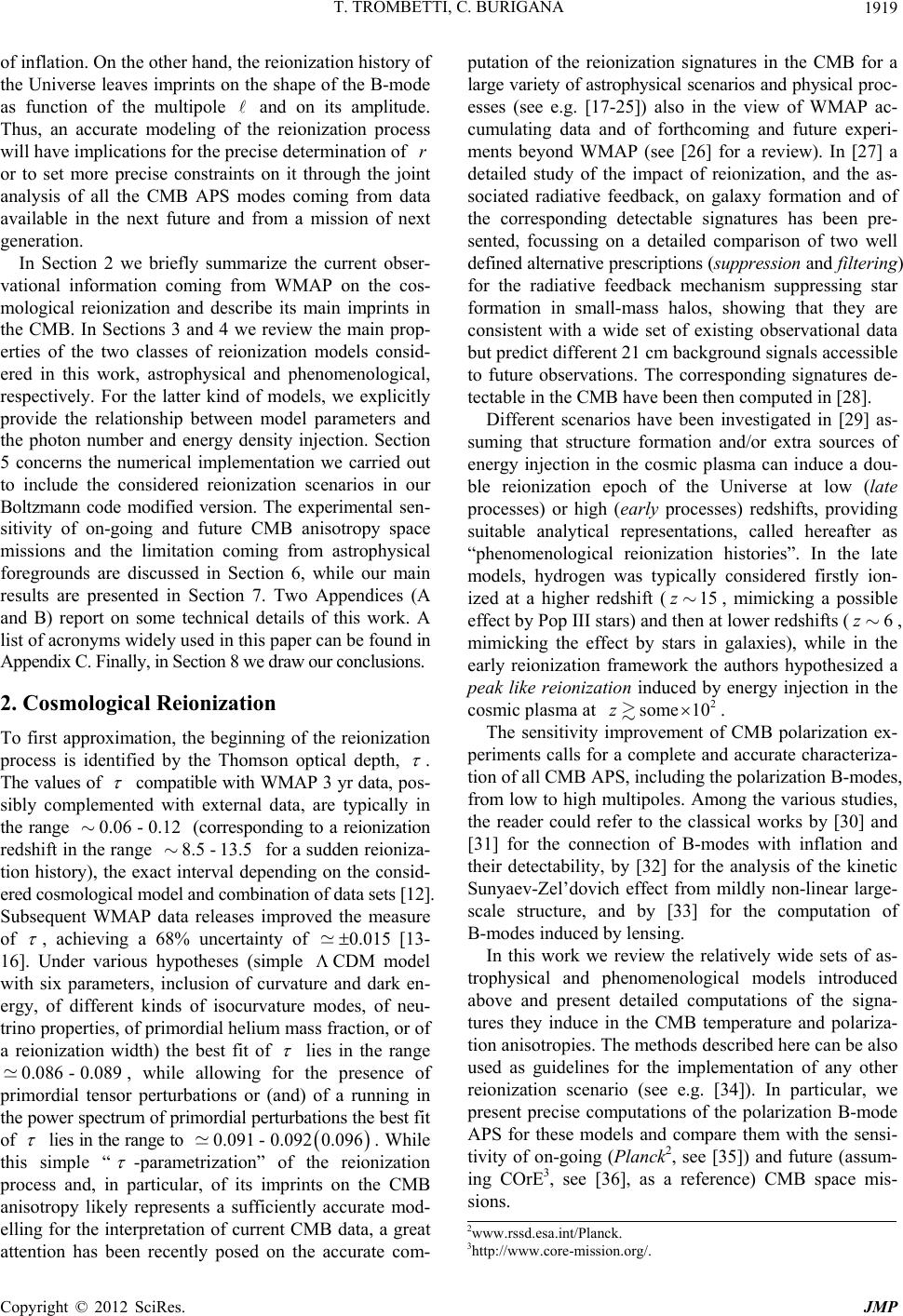 T. TROMBETTI, C. BURIGANA 1919 of inflation. On the other hand, the reionization history of the Universe leaves imprints on the shape of the B-mode as function of the multipole and on its amplitude. Thus, an accurate modeling of the reionization process will have implications for the precise determination of or to set more precise constraints on it through the joint analysis of all the CMB APS modes coming from data available in the next future and from a mission of next generation. r In Section 2 we briefly summarize the current obser- vational information coming from WMAP on the cos- mological reionization and describe its main imprints in the CMB. In Sections 3 and 4 we review the main prop- erties of the two classes of reionization models consid- ered in this work, astrophysical and phenomenological, respectively. For the latter kind of models, we explicitly provide the relationship between model parameters and the photon number and energy density injection. Section 5 concerns the numerical implementation we carried out to include the considered reionization scenarios in our Boltzmann code modified version. The experimental sen- sitivity of on-going and future CMB anisotropy space missions and the limitation coming from astrophysical foregrounds are discussed in Section 6, while our main results are presented in Section 7. Two Appendices (A and B) report on some technical details of this work. A list of acronyms widely used in this paper can be found in Appendix C. Finally, in Section 8 we draw our conclusions. 2. Cosmological Reionization To first approximation, the beginning of the reionization process is identified by the Thomson optical depth, . The values of compatible with WMAP 3 yr data, pos- sibly complemented with external data, are typically in the range (corresponding to a reionization redshift in the range for a sudden reioniza- tion history), the exact interval depending on the consid- ered cosmological model and combination of data sets [12]. Subsequent WMAP data releases improved the measure of 0.06 0.12 8.5 - 13.5 - , achieving a 68% uncertainty of [13- 16]. Under various hypotheses (simple CDM model with six parameters, inclusion of curvature and dark en- ergy, of different kinds of isocurvature modes, of neu- trino properties, of primordial helium mass fraction, or of a reionization width) the best fit of 0.015 lies in the range , while allowing for the presence of primordial tensor perturbations or (and) of a running in the power spectrum of primordial perturbations the best fit of 0.086 - 0.089 lies in the range to . While this simple “ 09.0960.091 - 0.20 -parametrization” of the reionization process and, in particular, of its imprints on the CMB anisotropy likely represents a sufficiently accurate mod- elling for the interpretation of current CMB data, a great attention has been recently posed on the accurate com- putation of the reionization signatures in the CMB for a large variety of astrophysical scenarios and physical proc- esses (see e.g. [17-25]) also in the view of WMAP ac- cumulating data and of forthcoming and future experi- ments beyond WMAP (see [26] for a review). In [27] a detailed study of the impact of reionization, and the as- sociated radiative feedback, on galaxy formation and of the corresponding detectable signatures has been pre- sented, focussing on a detailed comparison of two well defined alternative prescriptions (suppression and filtering) for the radiative feedback mechanism suppressing star formation in small-mass halos, showing that they are consistent with a wide set of existing observational data but predict different 21 cm background signals accessible to future observations. The corresponding signatures de- tectable in the CMB have been then computed in [28]. Different scenarios have been investigated in [29] as- suming that structure formation and/or extra sources of energy injection in the cosmic plasma can induce a dou- ble reionization epoch of the Universe at low (late processes) or high (early processes) redshifts, providing suitable analytical representations, called hereafter as “phenomenological reionization histories”. In the late models, hydrogen was typically considered firstly ion- ized at a higher redshift (, mimicking a possible effect by Pop III stars) and then at lower redshifts (z, mimicking the effect by stars in galaxies), while in the early reionization framework the authors hypothesized a peak like reionization induced by energy injection in the cosmic plasma at . 15z 6 2 some 10z The sensitivity improvement of CMB polarization ex- periments calls for a complete and accurate characteriza- tion of all CMB APS, including the polarization B-modes, from low to high multipoles. Among the various studies, the reader could refer to the classical works by [30] and [31] for the connection of B-modes with inflation and their detectability, by [32] for the analysis of the kinetic Sunyaev-Zel’dovich effect from mildly non-linear large- scale structure, and by [33] for the computation of B-modes induced by lensing. In this work we review the relatively wide sets of as- trophysical and phenomenological models introduced above and present detailed computations of the signa- tures they induce in the CMB temperature and polariza- tion anisotropies. The methods described here can be also used as guidelines for the implementation of any other reionization scenario (see e.g. [34]). In particular, we present precise computations of the polarization B-mode APS for these models and compare them with the sensi- tivity of on-going (Planck2, see [35]) and future (assum- ing COrE3, see [36], as a reference) CMB space mis- sions. 2www.rssd.esa.int/Planck. 3http://www.core-mission.org/. Copyright © 2012 SciRes. JMP 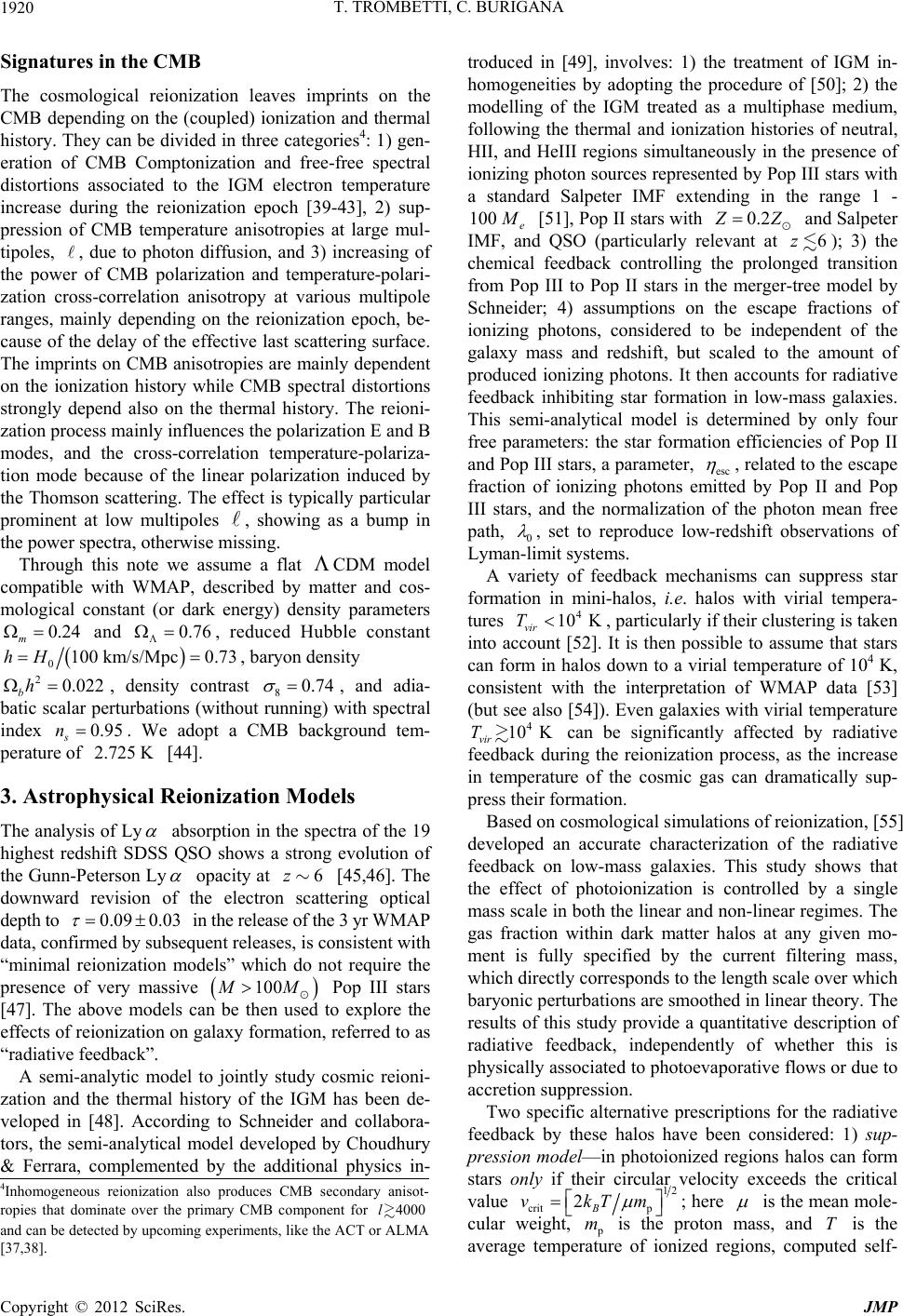 T. TROMBETTI, C. BURIGANA 1920 Signatures in the CMB The cosmological reionization leaves imprints on the CMB depending on the (coupled) ionization and thermal history. They can be divided in three categories4: 1) gen- eration of CMB Comptonization and free-free spectral distortions associated to the IGM electron temperature increase during the reionization epoch [39-43], 2) sup- pression of CMB temperature anisotropies at large mul- tipoles, , due to photon diffusion, and 3) increasing of the power of CMB polarization and temperature-polari- zation cross-correlation anisotropy at various multipole ranges, mainly depending on the reionization epoch, be- cause of the delay of the effective last scattering surface. The imprints on CMB anisotropies are mainly dependent on the ionization history while CMB spectral distortions strongly depend also on the thermal history. The reioni- zation process mainly influences the polarization E and B modes, and the cross-correlation temperature-polariza- tion mode because of the linear polarization induced by the Thomson scattering. The effect is typically particular prominent at low multipoles , showing as a bump in the power spectra, otherwise missing. 0.24 0.76 Through this note we assume a flat CDM model compatible with WMAP, described by matter and cos- mological constant (or dark energy) density parameters and , reduced Hubble constant m 0100 km/s/MpchH t 0.7 0.73 , baryon density 20.022 bh , density contras84 index n ure 5 K , and adia- batic scalar perturbations (without running) with spectral 0.95 s. We adopt a CMB background tem- of 2.72 perat [44]. 3. Astrophysical Reionization Models The analysis of Ly absorption in the spectra of the 19 highest redshift SDSS QSO shows a strong evolution of the Gunn-Peterson Ly opacity at [45,46]. The downward revision of the electron scattering optical depth to 6z 0.09 0.03 100MM 100 in the release of the 3 yr WMAP data, confirmed by subsequent releases, is consistent with “minimal reionization models” which do not require the presence of very massive Pop III stars [47]. The above models can be then used to explore the effects of reionization on galaxy formation, referred to as “radiative feedback”. A semi-analytic model to jointly study cosmic reioni- zation and the thermal history of the IGM has been de- veloped in [48]. According to Schneider and collabora- tors, the semi-analytical model developed by Choudhury & Ferrara, complemented by the additional physics in- troduced in [49], involves: 1) the treatment of IGM in- homogeneities by adopting the procedure of [50]; 2) the modelling of the IGM treated as a multiphase medium, following the thermal and ionization histories of neutral, HII, and HeIII regions simultaneously in the presence of ionizing photon sources represented by Pop III stars with a standard Salpeter IMF extending in the range 1 - e [51], Pop II stars with 0.2 Z 6z and Salpeter IMF, and QSO (particularly relevant at ); 3) the chemical feedback controlling the prolonged transition from Pop III to Pop II stars in the merger-tree model by Schneider; 4) assumptions on the escape fractions of ionizing photons, considered to be independent of the galaxy mass and redshift, but scaled to the amount of produced ionizing photons. It then accounts for radiative feedback inhibiting star formation in low-mass galaxies. This semi-analytical model is determined by only four free parameters: the star formation efficiencies of Pop II and Pop III stars, a parameter, esc , related to the escape fraction of ionizing photons emitted by Pop II and Pop III stars, and the normalization of the photon mean free path, 0 , set to reproduce low-redshift observations of Lyman-limit systems. A variety of feedback mechanisms can suppress star formation in mini-halos, i.e. halos with virial tempera- tures vir , particularly if their clustering is taken into account [52]. It is then possible to assume that stars can form in halos down to a virial temperature of 104 K, consistent with the interpretation of WMAP data [53] (but see also [54]). Even galaxies with virial temperature vir can be significantly affected by radiative feedback during the reionization process, as the increase in temperature of the cosmic gas can dramatically sup- press their formation. 4 10 KT 4 10 KT Based on cosmological simulations of reionization, [55] developed an accurate characterization of the radiative feedback on low-mass galaxies. This study shows that the effect of photoionization is controlled by a single mass scale in both the linear and non-linear regimes. The gas fraction within dark matter halos at any given mo- ment is fully specified by the current filtering mass, which directly corresponds to the length scale over which baryonic perturbations are smoothed in linear theory. The results of this study provide a quantitative description of radiative feedback, independently of whether this is physically associated to photoevaporative flows or due to accretion suppression. Two specific alternative prescriptions for the radiative feedback by these halos have been considered: 1) sup- pression model—in photoionized regions halos can form stars on ly if their circular velocity exceeds the critical value 4Inhomogeneous reionization also produces CMB secondary anisot- ropies that dominate over the primary CMB component for and can be detected by upcoming experiments, like the ACT or ALMA [37,38]. 12 2B vkTm crit p ; here is the mean mole- cular weight, 4000lm is the proton mass, and T is the average temperature of ionized regions, computed self- Copyright © 2012 SciRes. JMP 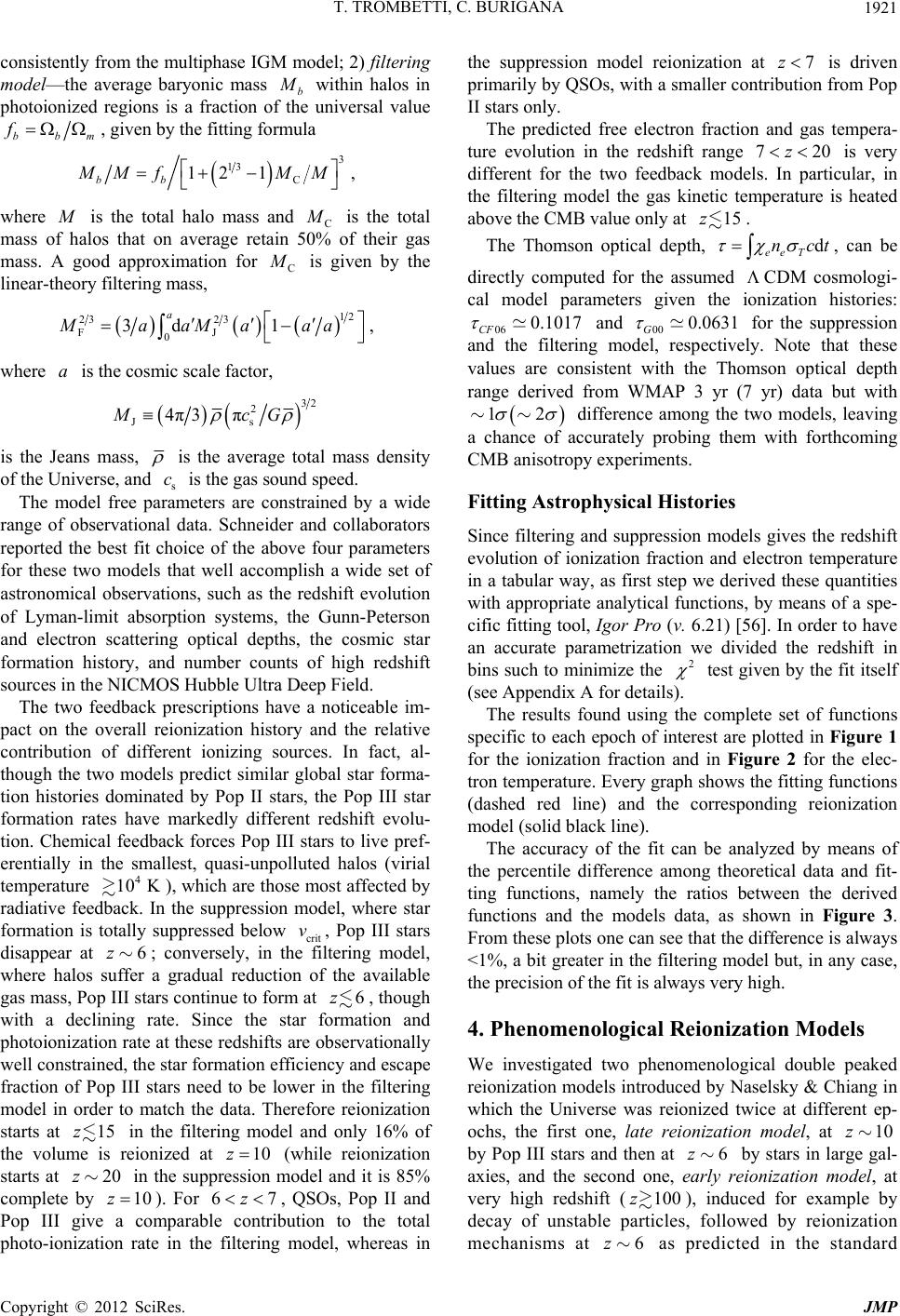 T. TROMBETTI, C. BURIGANA 1921 consistently from the multiphase IGM model; 2) filtering model—the average baryonic mass b within halos in photoionized regions is a fraction of the universal value bbm f , given by the fitting formula 3 13 C 12 1 bb MM MM f , where is the total halo mass and C is the total mass of halos that on average retain 50% of their gas mass. A good approximation for C is given by the linear-theory filtering mass, 12 1aaa a 23 23 FJ 0 3d a MaaM , where is the cosmic scale factor, 32 2 Js πMcG 4π3 is the Jeans mass, is the average total mass density of the Universe, and is the gas sound speed. s The model free parameters are constrained by a wide range of observational data. Schneider and collaborators reported the best fit choice of the above four parameters for these two models that well accomplish a wide set of astronomical observations, such as the redshift evolution of Lyman-limit absorption systems, the Gunn-Peterson and electron scattering optical depths, the cosmic star formation history, and number counts of high redshift sources in the NICMOS Hubble Ultra Deep Field. c 4 10 K v 6z 6z 15z z 7 The two feedback prescriptions have a noticeable im- pact on the overall reionization history and the relative contribution of different ionizing sources. In fact, al- though the two models predict similar global star forma- tion histories dominated by Pop II stars, the Pop III star formation rates have markedly different redshift evolu- tion. Chemical feedback forces Pop III stars to live pref- erentially in the smallest, quasi-unpolluted halos (virial temperature ), which are those most affected by radiative feedback. In the suppression model, where star formation is totally suppressed below crit , Pop III stars disappear at ; conversely, in the filtering model, where halos suffer a gradual reduction of the available gas mass, Pop III stars continue to form at , though with a declining rate. Since the star formation and photoionization rate at these redshifts are observationally well constrained, the star formation efficiency and escape fraction of Pop III stars need to be lower in the filtering model in order to match the data. Therefore reionization starts at in the filtering model and only 16% of the volume is reionized at (while reionization starts at in the suppression model and it is 85% complete by ). For 10z 6z 20 10z , QSOs, Pop II and Pop III give a comparable contribution to the total photo-ionization rate in the filtering model, whereas in the suppression model reionization at is driven primarily by QSOs, with a smaller contribution from Pop II stars only. 7z 720z 15z d ee T nct 0.1017 The predicted free electron fraction and gas tempera- ture evolution in the redshift range is very different for the two feedback models. In particular, in the filtering model the gas kinetic temperature is heated above the CMB value only at . The Thomson optical depth, , can be directly computed for the assumed CDM cosmologi- cal model parameters given the ionization histories: 06CF 0.0631 and 00G for the suppression and the filtering model, respectively. Note that these values are consistent with the Thomson optical depth range derived from WMAP 3 yr (7 yr) data but with 12 2 difference among the two models, leaving a chance of accurately probing them with forthcoming CMB anisotropy experiments. Fitting Astrophysical Histories Since filtering and suppression models gives the redshift evolution of ionization fraction and electron temperature in a tabular way, as first step we derived these quantities with appropriate analytical functions, by means of a spe- cific fitting tool, Igor Pro (v. 6.21) [56]. In order to have an accurate parametrization we divided the redshift in bins such to minimize the test given by the fit itself (see Appendix A for details). The results found using the complete set of functions specific to each epoch of interest are plotted in Figure 1 for the ionization fraction and in Figure 2 for the elec- tron temperature. Every graph shows the fitting functions (dashed red line) and the corresponding reionization model (solid black line). The accuracy of the fit can be analyzed by means of the percentile difference among theoretical data and fit- ting functions, namely the ratios between the derived functions and the models data, as shown in Figure 3. From these plots one can see that the difference is always <1%, a bit greater in the filtering model but, in any case, the precision of the fit is always very high. 4. Phenomenological Reionization Models We investigated two phenomenological double peaked reionization models introduced by Naselsky & Chiang in which the Universe was reionized twice at different ep- ochs, the first one, late reionization model, at by Pop III stars and then at by stars in large gal- axies, and the second one, early reionization model, at very high redshift (), induced for example by decay of unstable particles, followed by reionization echanisms at as predicted in the standard 10z 6z 100z 6z m Copyright © 2012 SciRes. JMP 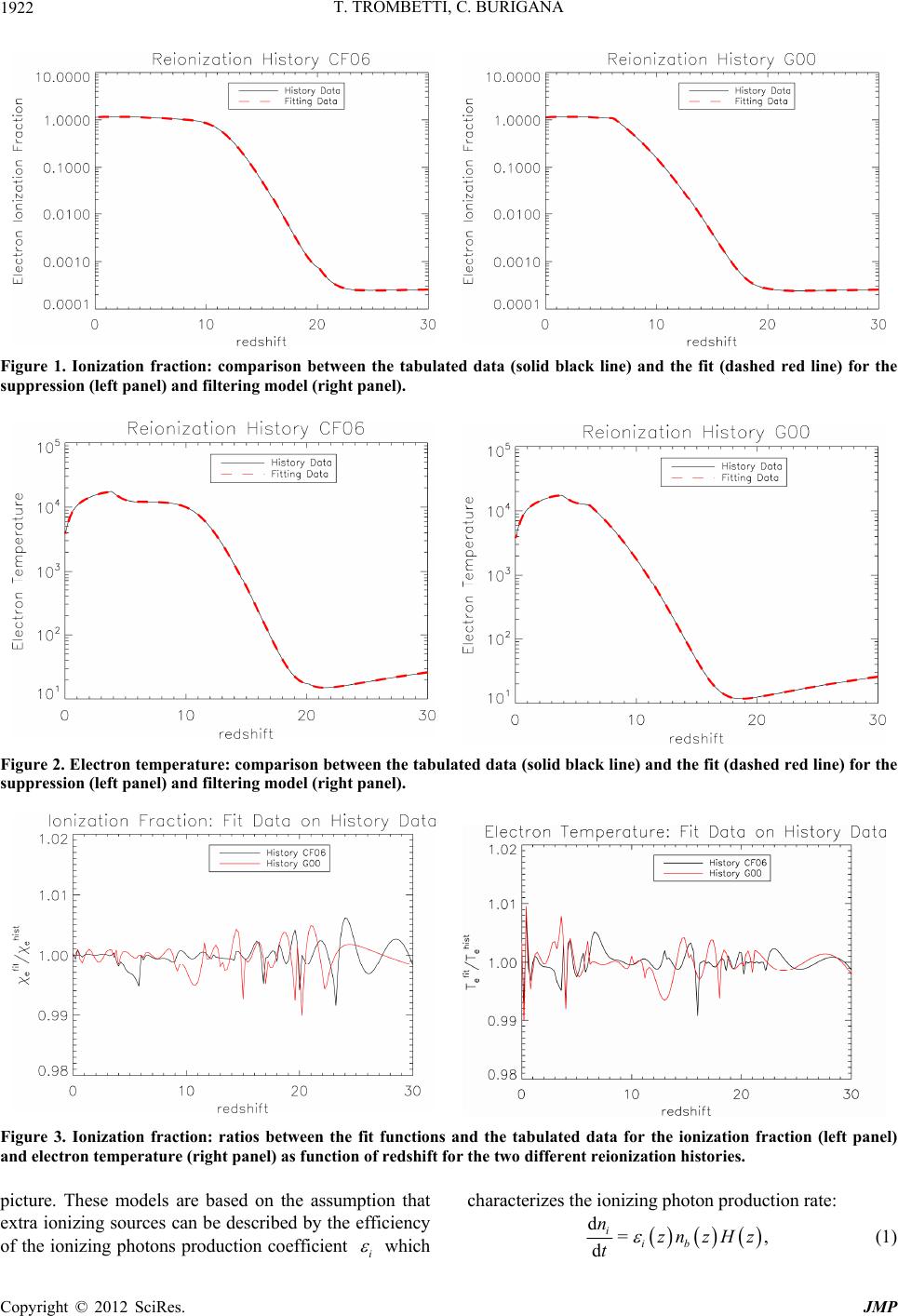 T. TROMBETTI, C. BURIGANA JMP 1922 Figure 1. Ionization fraction: comparison between the tabulated data (solid black line) and the fit (dashed red line) for the suppression (left panel) and filtering model (r ight pane l). Figure 2. Electron temperature: comparison between the tabulated data (solid black line) and the fit (dashed red line) for the suppression (left panel) and filtering model (r ight pane l). Figure 3. Ionization fraction: ratios between the fit functions and the tabulated data for the ionization fraction (left panel) and electron temperature (right panel) as function of redshift for the two different reionization histories. picture. These models are based on the assumption that extra ionizing sources can be described by the efficiency characterizes the ionizing photon production rate: Copyright © 2012 SciRes. of the ionizing photons production coefficient i which d=, d iib nzn zHz t (1) 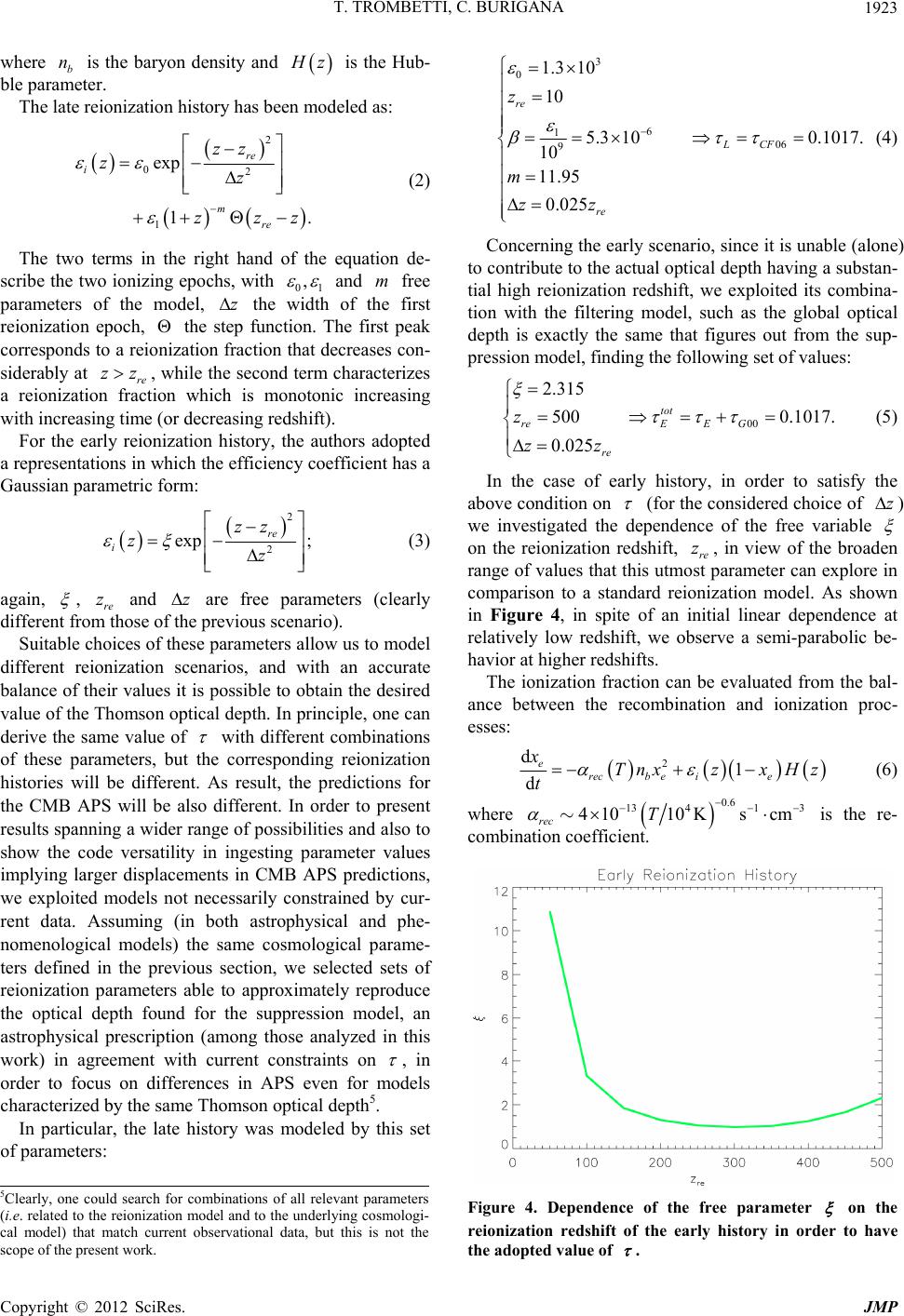 T. TROMBETTI, C. BURIGANA 1923 where b is the baryon density and n z is the Hub- ble parameter. The late reionization history has been modeled as: 0 1 exp iz 2 2 1. re m re zz z zzz , (2) The two terms in the right hand of the equation de- scribe the two ionizing epochs, with 01 m z z and free parameters of the model, the width of the first reionization epoch, the step function. The first peak corresponds to a reionization fraction that decreases con- siderably at re , while the second term characterizes a reionization fraction which is monotonic increasing with increasing time (or decreasing redshift). z For the early reionization history, the authors adopted a representations in which the efficiency coefficient has a Gaussian parametric form: 2 2; re zz z exp iz (3) again, , re and are free parameters (clearly different from those of the previous scenario). zz Suitable choices of these parameters allow us to model different reionization scenarios, and with an accurate balance of their values it is possible to obtain the desired value of the Thomson optical depth. In principle, one can derive the same value of with different combinations of these parameters, but the corresponding reionization histories will be different. As result, the predictions for the CMB APS will be also different. In order to present results spanning a wider range of possibilities and also to show the code versatility in ingesting parameter values implying larger displacements in CMB APS predictions, we exploited models not necessarily constrained by cur- rent data. Assuming (in both astrophysical and phe- nomenological models) the same cosmological parame- ters defined in the previous section, we selected sets of reionization parameters able to approximately reproduce the optical depth found for the suppression model, an astrophysical prescription (among those analyzed in this work) in agreement with current constraints on , in order to focus on differences in APS even for models characterized by the same Thomson optical depth5. In particular, the late history was modeled by this set of parameters: 3 0 6 1 06 9 1.3 10 10 5.3 100.1017. 10 11.95 0.025 re LCF re z m zz 00 2.315 500 0.1017. 0.025 tot reEE G re z zz (4) Concerning the early scenario, since it is unable (alone) to contribute to the actual optical depth having a substan- tial high reionization redshift, we exploited its combina- tion with the filtering model, such as the global optical depth is exactly the same that figures out from the sup- pression model, finding the following set of values: (5) In the case of early history, in order to satisfy the above condition on z (for the considered choice of ) we investigated the dependence of the free variable on the reionization redshift, re, in view of the broaden range of values that this utmost parameter can explore in comparison to a standard reionization model. As shown in Figure 4, in spite of an initial linear dependence at relatively low redshift, we observe a semi-parabolic be- havior at higher redshifts. z The ionization fraction can be evaluated from the bal- ance between the recombination and ionization proc- esses: 2 d1 d erecb eie xTnxzx Hz t (6) where 0.6 1341 3 41010Ks cmT rec is the re- combination coefficient. 5Clearly, one could search for combinations of all relevant parameters (i.e. related to the reionization model and to the underlying cosmologi- cal model) that match current observational data, but this is not the scope of the present work. Figure 4. Dependence of the free parameter on the reionization redshift of the early history in order to have the adopted value of . Copyright © 2012 SciRes. JMP 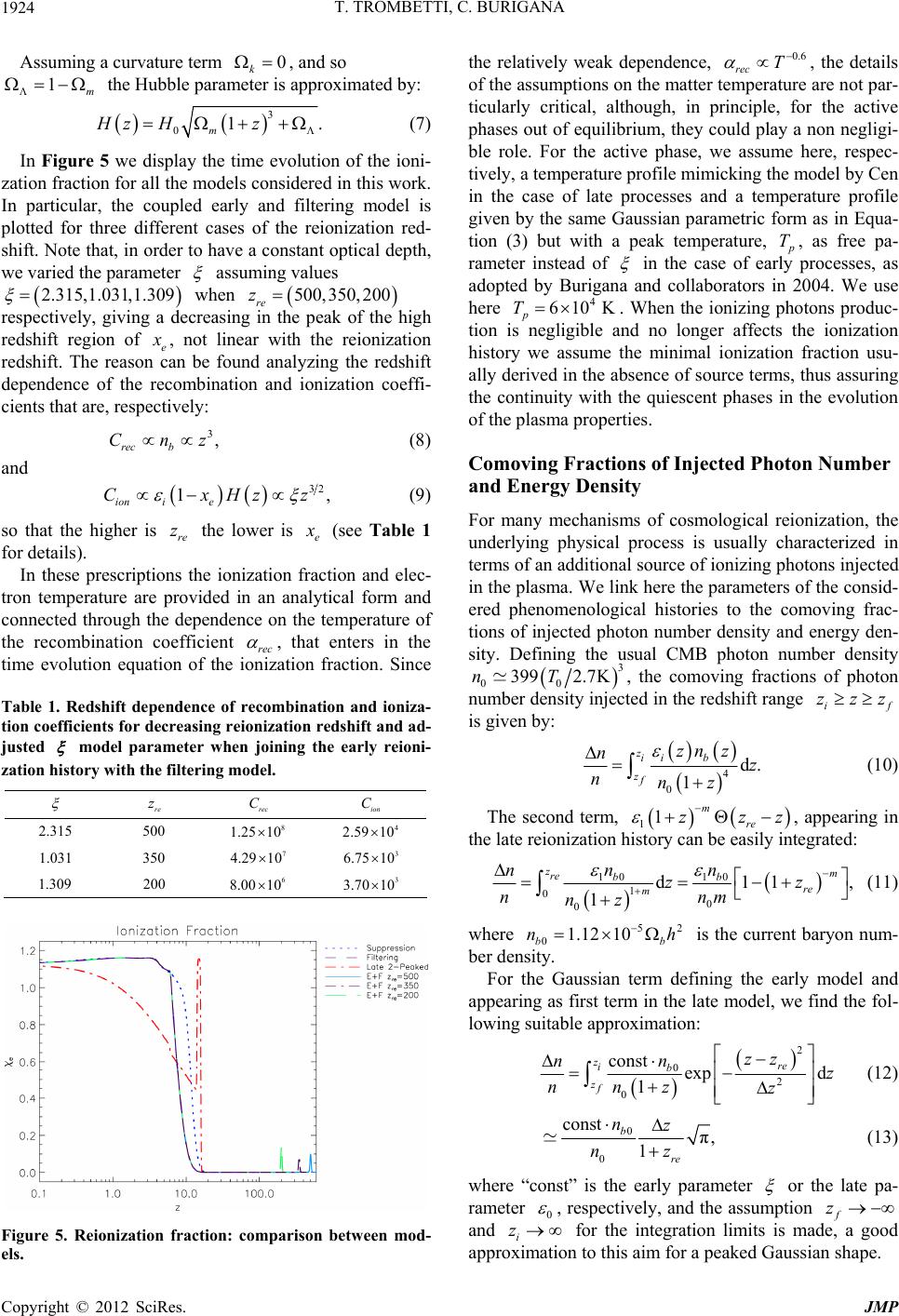 T. TROMBETTI, C. BURIGANA 1924 Assuming a curvature term k0 1m , and so the Hubble parameter is approximated by: 3 1.z 0m Hz H (7) In Figure 5 we display the time evolution of the ioni- zation fraction for all the models considered in this work. In particular, the coupled early and filtering model is plotted for three different cases of the reionization red- shift. Note that, in order to have a constant optical depth, we varied the parameter assuming values 1.309 z2.315, 1.031, 500,350,200 when re respectively, giving a decreasing in the peak of the high redshift region of e , not linear with the reionization redshift. The reason can be found analyzing the redshift dependence of the recombination and ionization coeffi- cients that are, respectively: 3, rec b Cnz (8) and 32 1,Hzz re ze ion ie Cx (9) so that the higher is the lower is (see Table 1 for details). In these prescriptions the ionization fraction and elec- tron temperature are provided in an analytical form and connected through the dependence on the temperature of the recombination coefficient rec , that enters in the time evolution equation of the ionization fraction. Since Table 1. Redshift dependence of recombination and ioniza- tion coefficients for decreasing reionization redshift and ad- justed model parameter when joining the early reioni- zation history with the filtering model. re z rec C ion C 2.315 500 8 1.25 10 4 2.59 10 1.031 350 7 4.29 10 3 6.75 10 3 3.70 10 1.309 200 6 8.00 10 Figure 5. Reionization fraction: comparison between mod- els. the relatively weak dependence, rec , the details of the assumptions on the matter temperature are not par- ticularly critical, although, in principle, for the active phases out of equilibrium, they could play a non negligi- ble role. For the active phase, we assume here, respec- tively, a temperature profile mimicking the model by Cen in the case of late processes and a temperature profile given by the same Gaussian parametric form as in Equa- tion (3) but with a peak temperature, 0.6 T T, as free pa- rameter instead of in the case of early processes, as adopted by Burigana and collaborators in 2004. We use here p. When the ionizing photons produc- tion is negligible and no longer affects the ionization history we assume the minimal ionization fraction usu- ally derived in the absence of source terms, thus assuring the continuity with the quiescent phases in the evolution of the plasma properties. 4 610KT Comoving Fractions of Injected Photon Number and Energy Density For many mechanisms of cosmological reionization, the underlying physical process is usually characterized in terms of an additional source of ionizing photons injected in the plasma. We link here the parameters of the consid- ered phenomenological histories to the comoving frac- tions of injected photon number density and energy den- sity. Defining the usual CMB photon number density 3 399 2.7KnT if zzz 00 , the comoving fractions of photon number density injected in the redshift range is given by: 4 0 d. 1 zib i zf zn z nz nnz 1m zzz (10) The second term, 1re , appearing in the late reionization history can be easily integrated: 10 10 1 0 0 0 d11, 1 zm re bb re m nn nzz nnm nz 52 1.12 10b nh (11) where 0b is the current baryon num- ber density. For the Gaussian term defining the early model and appearing as first term in the late model, we find the fol- lowing suitable approximation: 2 0 2 0 const exp d 1 zre ib zf zz n nz nnz z (12) 0 0 const π, 1 b re nz nz (13) where “const” is the early parameter or the late pa- rameter 0 , respectively, and the assumption f and i for the integration limits is made, a good approximation to this aim for a peaked Gaussian shape. z z Copyright © 2012 SciRes. JMP 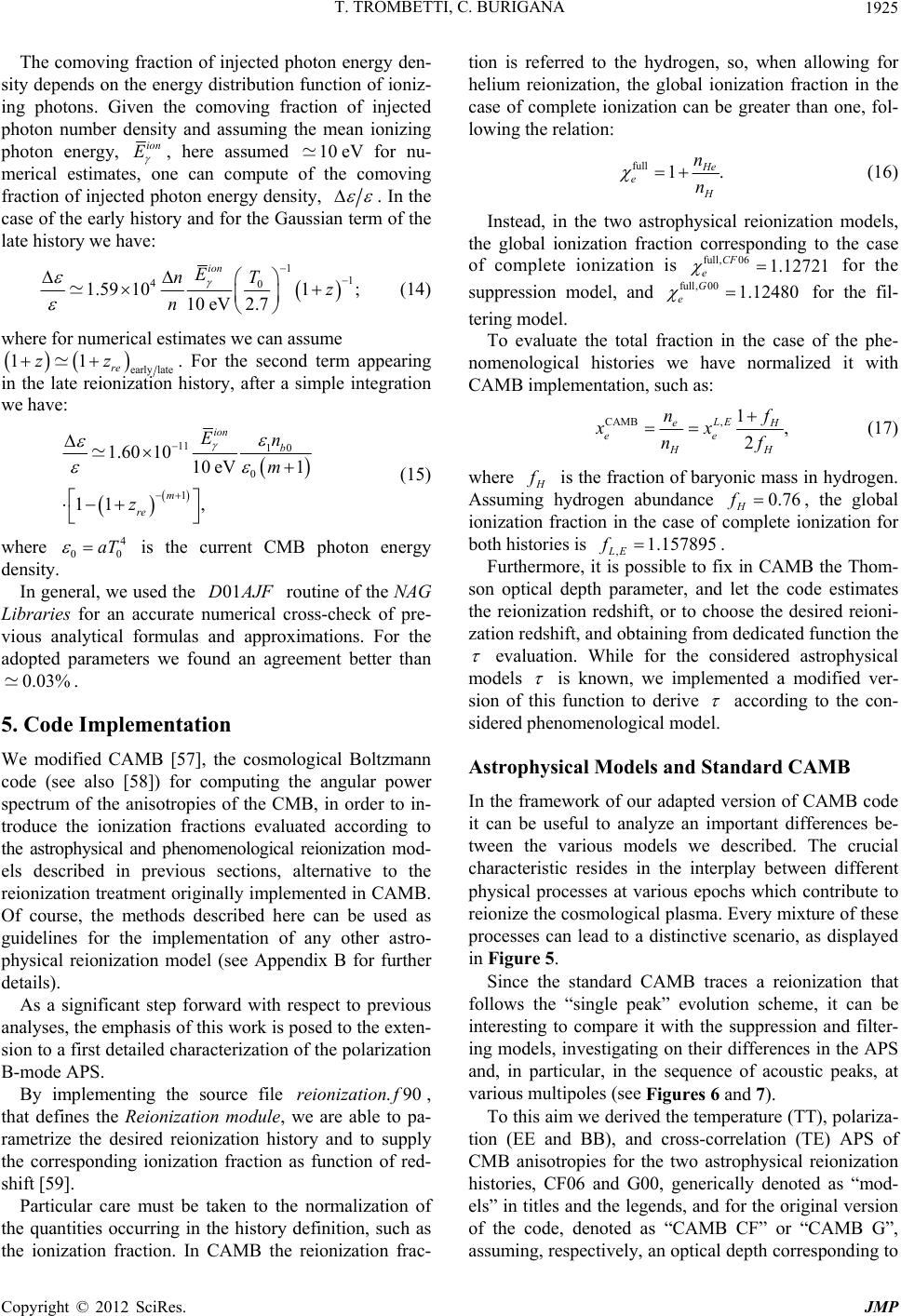 T. TROMBETTI, C. BURIGANA 1925 The comoving fraction of injected photon energy den- sity depends on the energy distribution function of ioniz- ing photons. Given the comoving fraction of injected photon number density and assuming the mean ionizing photon energy, ion E , here assumed eV for nu- merical estimates, one can compute of the comoving fraction of injected photon energy density, 10 . In the case of the early history and for the Gaussian term of the late history we have: 1 1 1 ; 7z 40 1.59 1010eV2. ion ET n n (14) where for numerical estimates we can assume early late re . For the second term appearing in the late reionization history, after a simple integration we have: 11zz 11 1 1.601010 11 , m re E z 10 0 eV 1 ion b n m 00 aT y. 01DAJF 0.03% .90ionizationf (15) where 4 is the current CMB photon energy densit In general, we used the routine of the NAG Libraries for an accurate numerical cross-check of pre- vious analytical formulas and approximations. For the adopted parameters we found an agreement better than . 5. Code Implementation We modified CAMB [57], the cosmological Boltzmann code (see also [58]) for computing the angular power spectrum of the anisotropies of the CMB, in order to in- troduce the ionization fractions evaluated according to the astrophysical and phenomenological reionization mod- els described in previous sections, alternative to the reionization treatment originally implemented in CAMB. Of course, the methods described here can be used as guidelines for the implementation of any other astro- physical reionization model (see Appendix B for further details). As a significant step forward with respect to previous analyses, the emphasis of this work is posed to the exten- sion to a first detailed characterization of the polarization B-mode APS. By implementing the source file , that defines the Reionization module, we are able to pa- rametrize the desired reionization history and to supply the corresponding ionization fraction as function of red- shift [59]. re Particular care must be taken to the normalization of the quantities occurring in the history definition, such as the ionization fraction. In CAMB the reionization frac- tion is referred to the hydrogen, so, when allowing for helium reionization, the global ionization fraction in the case of complete ionization can be greater than one, fol- lowing the relation: full 1. e eH n n full, 061.12721 CF e full, 001.12480 G e (16) Instead, in the two astrophysical reionization models, the global ionization fraction corresponding to the case of complete ionization is for the suppression model, and for the fil- tering model. To evaluate the total fraction in the case of the phe- nomenological histories we have normalized it with CAMB implementation, such as: CAMB,1, 2 LE eH ee HH n xx nf (17) where is the fraction of baryonic mass in hydrogen. Assuming hydrogen abundance H, the global ionization fraction in the case of complete ionization for both histories is 0.76f 1.157895f,LE. Furthermore, it is possible to fix in CAMB the Thom- son optical depth parameter, and let the code estimates the reionization redshift, or to choose the desired reioni- zation redshift, and obtaining from dedicated function the evaluation. While for the considered astrophysical models is known, we implemented a modified ver- sion of this function to derive according to the con- sidered phenomenological model. Astrophysical Models and Standard CAMB In the framework of our adapted version of CAMB code it can be useful to analyze an important differences be- tween the various models we described. The crucial characteristic resides in the interplay between different physical processes at various epochs which contribute to reionize the cosmological plasma. Every mixture of these processes can lead to a distinctive scenario, as displayed in Figure 5. Since the standard CAMB traces a reionization that follows the “single peak” evolution scheme, it can be interesting to compare it with the suppression and filter- ing models, investigating on their differences in the APS and, in particular, in the sequence of acoustic peaks, at various multipoles (see Figures 6 and 7). To this aim we derived the temperature (TT), polariza- tion (EE and BB), and cross-correlation (TE) APS of CMB anisotropies for the two astrophysical reionization histories, CF06 and G00, generically denoted as “mod- els” in titles and the legends, and for the original version of the code, denoted as “CAMB CF” or “CAMB G”, assuming, respectively, an opt cal depth corresponding to i Copyright © 2012 SciRes. JMP 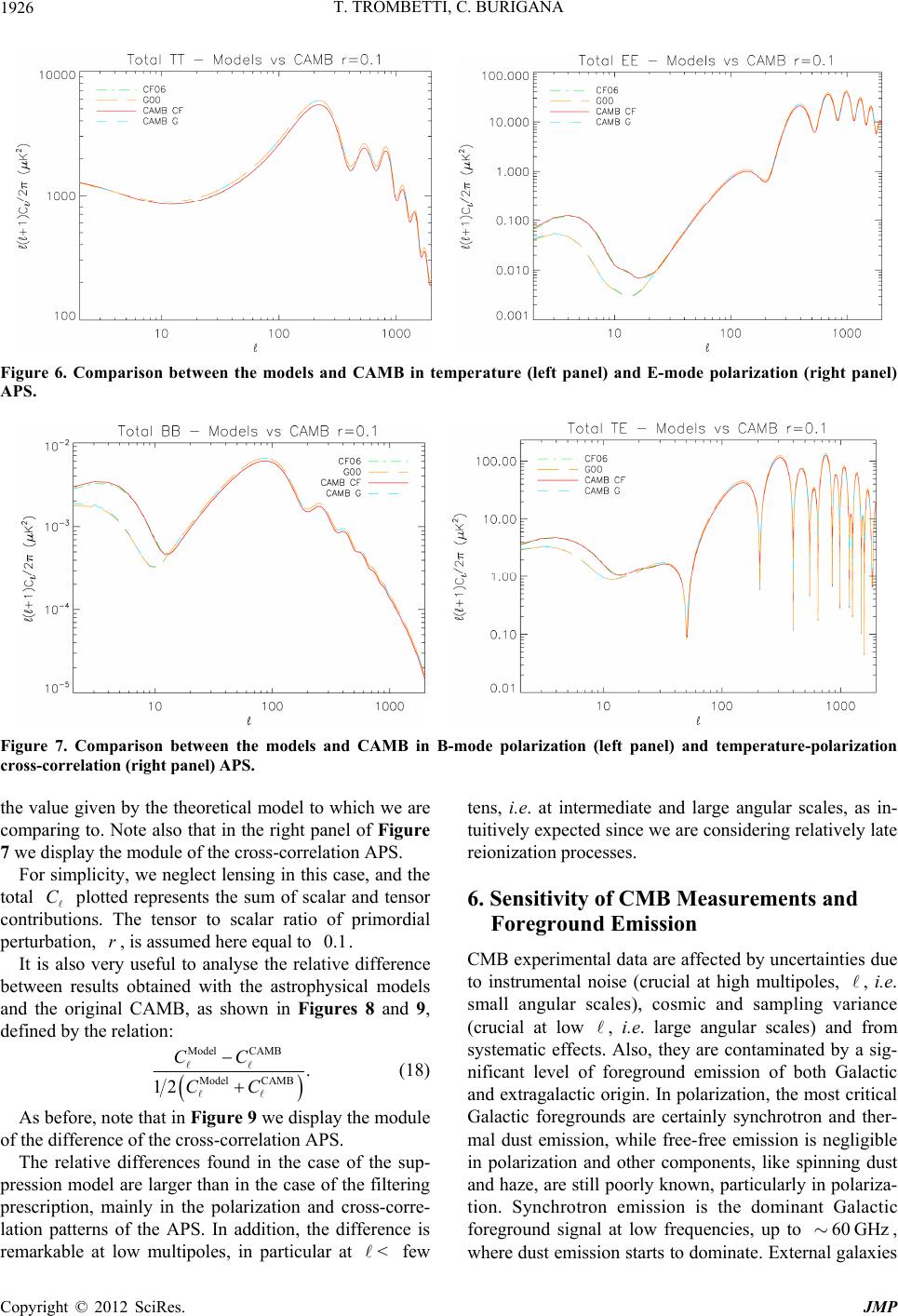 T. TROMBETTI, C. BURIGANA Copyright © 2012 SciRes. JMP 1926 Figure 6. Comparison between the models and CAMB in temperature (left panel) and E-mode polarization (right panel) APS. Figure 7. Comparison between the models and CAMB in B-mode polarization (left panel) and temperature-polarization cross-correlation (r ight pane l) APS. the value given by the theoretical model to which we are comparing to. Note also that in the right panel of Figure 7 we display the module of the cross-correlation APS. For simplicity, we neglect lensing in this case, and the total plotted represents the sum of scalar and tensor contributions. The tensor to scalar ratio of primordial perturbation, , is assumed here equal to . C r0.1 It is also very useful to analyse the relative difference between results obtained with the astrophysical models and the original CAMB, as shown in Figures 8 and 9, defined by the relation: Model CAMB CAMB . CC CC < 60 GHz Model 12 (18) As before, note that in Figure 9 we display the module of the difference of the cross-correlation APS. The relative differences found in the case of the sup- pression model are larger than in the case of the filtering prescription, mainly in the polarization and cross-corre- lation patterns of the APS. In addition, the difference is remarkable at low multipoles, in particular at few tens, i.e. at intermediate and large angular scales, as in- tuitively expected since we are considering relatively late reionization processes. 6. Sensitivity of CMB Measurements and Foreground Emission CMB experimental data are affected by uncertainties due to instrumental noise (crucial at high multipoles, , i.e. small angular scales), cosmic and sampling variance (crucial at low , i.e. large angular scales) and from systematic effects. Also, they are contaminated by a sig- nificant level of foreground emission of both Galactic and extragalactic origin. In polarization, the most critical Galactic foregrounds are certainly synchrotron and ther- mal dust emission, while free-free emission is negligible in polarization and other components, like spinning dust and haze, are still poorly known, particularly in polariza- tion. Synchrotron emission is the dominant Galactic foreground signal at low frequencies, up to , where dust emission starts to dominate. External galaxies 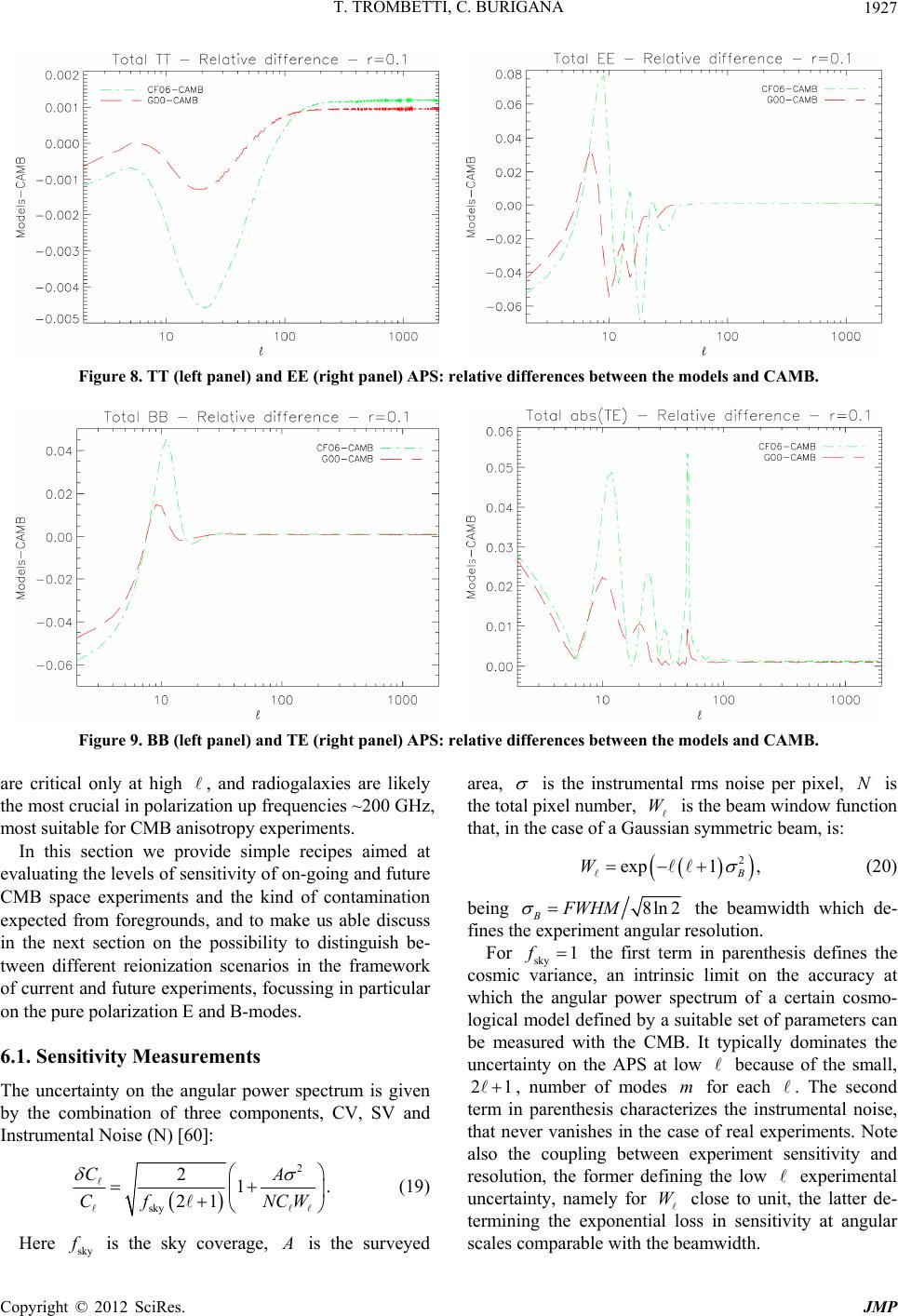 T. TROMBETTI, C. BURIGANA 1927 Figure 8. TT (left panel) and EE (right panel) APS: relative differences between the models and CAMB. Figure 9. BB (left panel) and TE (right panel) APS: relative differences between the models and CAMB. are critical only at high , and radiogalaxies are likely the most crucial in polarization up frequencies ~200 GHz, most suitable for CMB anisotropy experiments. In this section we provide simple recipes aimed at evaluating the levels of sensitivity of on-going and future CMB space experiments and the kind of contamination expected from foregrounds, and to make us able discuss in the next section on the possibility to distinguish be- tween different reionization scenarios in the framework of current and future experiments, focussing in particular on the pure polarization E and B-modes. 6.1. Sensitivity Measurements The uncertainty on the angular power spectrum is given by the combination of three components, CV, SV and Instrumental Noise (N) [60]: 2 1. CA NCW sky sky 2 21 Cf (19) Here is the sky coverage, is the surveyed area, is the instrumental rms noise per pixel, is the total pixel number, is the beam window function that, in the case of a Gaussian symmetric beam, is: N W 2 exp1 , B W (20) 8ln2FWHM 1f being B the beamwidth which de- fines the experiment angular resolution. For sky the first term in parenthesis defines the cosmic variance, an intrinsic limit on the accuracy at which the angular power spectrum of a certain cosmo- logical model defined by a suitable set of parameters can be measured with the CMB. It typically dominates the uncertainty on the APS at low because of the small, 21 m W , number of modes for each . The second term in parenthesis characterizes the instrumental noise, that never vanishes in the case of real experiments. Note also the coupling between experiment sensitivity and resolution, the former defining the low experimental uncertainty, namely for close to unit, the latter de- termining the exponential loss in sensitivity at angular scales comparable with the beamwidth. Copyright © 2012 SciRes. JMP  T. TROMBETTI, C. BURIGANA 1928 In order to provide concrete estimates of these quanti- ties, we consider Planck LFI and HFI channels at , and COrE channels at , i.e. at the frequen- cies particularly suitable for CMB analyses because of the combination of good experimental sensitivity and resolution, and of relatively low foreground contamina- tion. We adopt here the sensitivities and resolutions summarized in the COrE white paper6. 70,100,1 75,105, 43,217GHz 95,225GHz 135,165,1 For each of the two projects we computed an overall sensitivity value, weighted over the channels, defined by 22 ,, 11 i . totj i jPol 5% (21) where , and i states for the sensitivity of each frequency channel, listed in Tables 2 and 3. FWHM values of 13 and 14 are used to define the overall resolution respectively of Planck and COrE in the com- putation of the beam window function7. T Finally, to improve the signal to noise ratio in the APS sensitivity, especially at high multipoles, we will apply a multipole binning of in temperature APS, 15% in TE cross-correlation and 30% in polarization APS, both in E and B-modes. Table 2. Instrumental sensitivity of Planck experiment . GHz arcminFWHM μKarcmin T μKarcmin Pol 70 13 211.2 298.7 100 9.9 31.3 44.2 33.3 49.4 143 7.2 20.1 217 4.9 28.5 Table 3. Instrumental sensitivity of COrE experiment. GHz arcminFWHM μKarcmin T 6.2. Parametrization of Residual Polarized Foreground Contamination The parametrization of the APS of Galactic thermal dust and synchrotron emission adopted in this work is taken from the results of WMAP 3-yrs [61] under the assump- tion that these contributions are uncorrelated8, and is expressed by: μKarcmin Pol 75 14 2.73 4.72 105 4.63 4.55 4.61 4.54 4.57 10 2.68 135 7.8 2.63 165 6.4 2.67 195 5.4 2.63 225 4.7 2.64 22 16565 , 2π sd ore m sd C (22) where and stands for synchrotron and dust, and the frequency d is expressed in GHz. The coefficients characterizing the E and B-modes polarization APS are slightly different, and are listed in Table 4. In the next sections we will parametrize a potential re- sidual from non perfect cleaning of CMB maps from Galactic foregrounds simply assuming that a certain frac- tion of the foreground signal at map level (or, equiva- lently, its square at power spectrum level) contaminates CMB maps. Of course, one can easily rescale the fol- lowing results to any fraction of residual foreground contamination. The frequency of 70 GHz, i.e. the Planck channel where Galactic foreground is expected to be minimum at least at angular scales above one degree, will be adopted as reference. 0.1 10% 30% 2 μK For what concerns extragalactic source fluctuations [62,63], we will adopt the recent (conservative) estimate of their Poissonian contribution to the APS [64] at 100 GHz9 assuming a detection threshold of Jy, to- gether with a potential residual coming from an uncer- tainty in the subtraction of this contribution computed assuming a relative uncertainty of in the knowl- edge of their degree of polarization and in the determina- tion of the source detection threshold, implying a reduc- tion to of the original level [65]. Except at very high multipoles, their residual is likely significantly be- low that coming from Galactic foregrounds. 7. Results In this section we present the angular power spectra Table 4. Parametrization of E and B mode polarization power spectra of Galactic synchrotron and thermal dust emission. m 2 μK B-mode E-mode m sync 0.36 3.00.60.3 2.80.6 sync dust 1.001.50.6 0.51.50.6 dust 6The nominal sensitivity of Planck is slightly better than that adopted here thanks the slightly longer extension of the mission with both in- struments, and the additional extension with the only LFI. Of course, the real sensitivity of the whole mission will have to include also the otential residuals of systematic effects. 7In fact, it is possible to smooth maps acquired at higher frequencies with smaller beamwidths to the resolution corresponding to the lowest frequency of each experiment. 8A more sophisticated treatment of the foreground power spectra takes into account the correlation among the various foreground components. 9We adopt here a frequency slightly larger than that considered fo Galactic foregrounds because at small angular scales, where point sources are more critical, the minimum of foreground contamination is likely shifted at higher frequencies. Copyright © 2012 SciRes. JMP 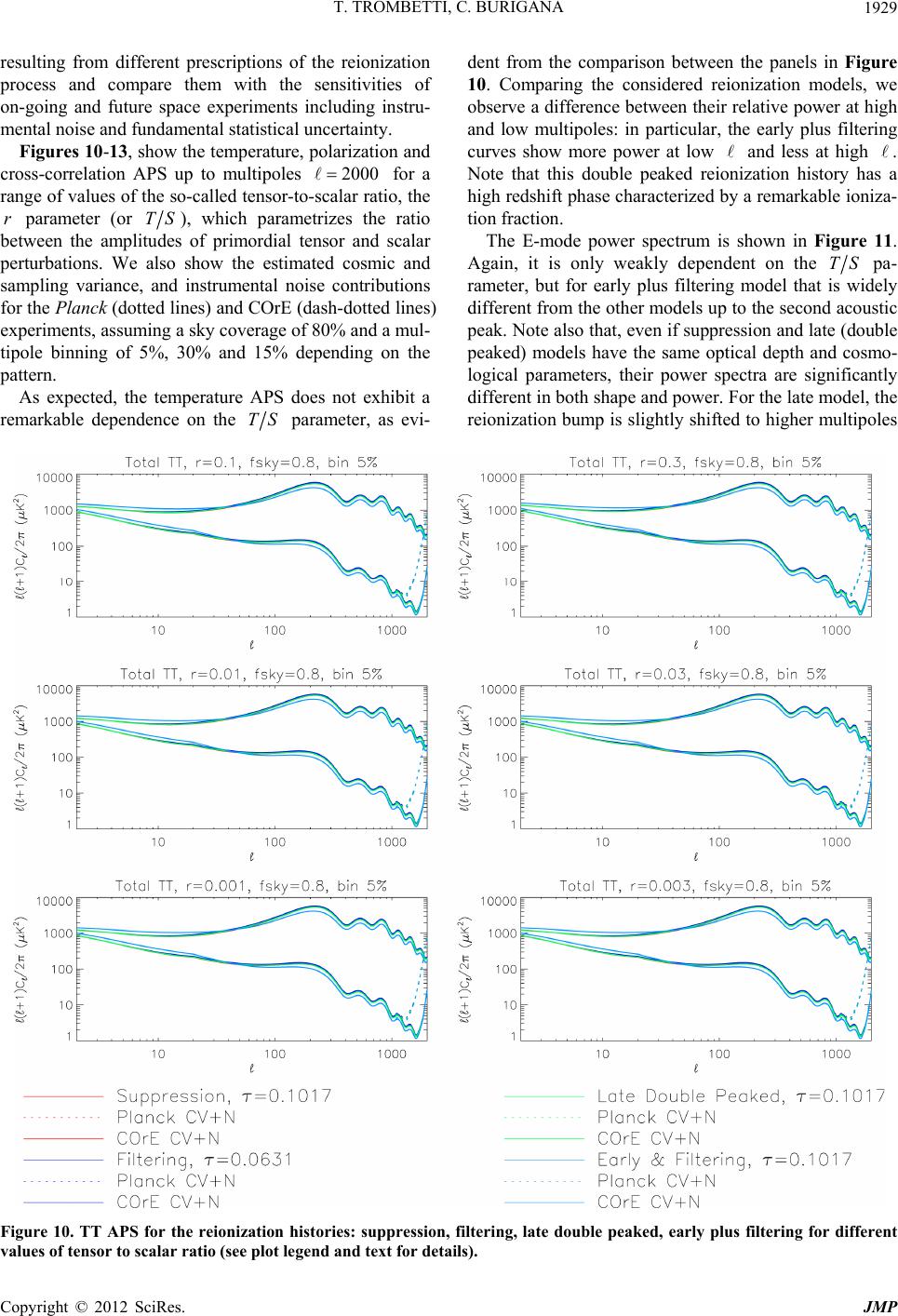 T. TROMBETTI, C. BURIGANA JMP 1929 2000 r resulting from different prescriptions of the reionization process and compare them with the sensitivities of on-going and future space experiments including instru- mental noise and fundamental statistical uncertainty. Figures 10-13, show the temperature, polarization and cross-correlation APS up to multipoles for a range of values of the so-called tensor-to-scalar ratio, the parameter (or Copyright © 2012 SciRes. TS), which parametrizes the ratio between the amplitudes of primordial tensor and scalar perturbations. We also show the estimated cosmic and sampling variance, and instrumental noise contributions for the Planck (dotted lines) and COrE (dash-dotted lines) experiments, assuming a sky coverage of 80% and a mul- tipole binning of 5%, 30% and 15% depending on the pattern. As expected, the temperature APS does not exhibit a remarkable dependence on the TS parameter, as evi- dent from the comparison between the panels in Figure 10. Comparing the considered reionization models, we observe a difference between their relative power at high and low multipoles: in particular, the early plus filtering curves show more power at low and less at high . Note that this double peaked reionization history has a high redshift phase characterized by a remarkable ioniza- tion fraction. The E-mode power spectrum is shown in Figure 11. Again, it is only weakly dependent on the T pa- rameter, but for early plus filtering model that is widely different from the other models up to the second acoustic peak. Note also that, even if suppression and late (double peaked) models have the same optical depth and cosmo- logical parameters, their power spectra are significantly different in both shape and power. For the late model, the reionization bump is slightly shifted to higher multipoles S Figure 10. TT APS for the reionization histories: suppression, filtering, late double peaked, early plus filtering for different values of tensor to scalar ratio (see plot legend and text for details).  T. TROMBETTI, C. BURIGANA 1930 Figure 11. EE APS for the reionization histories: suppression, filtering, late double peaked, early plus filtering for different values of tensor to scalar ratio r (see plot legend and text for details). with respect to the other histories. The B-mode power spectrum (see Figure 12) plotted here including also the lensing contribution, shows the expected linear dependence on TS r 70 1 at low multipoles, where the primordial signal dominates over the lensing contribution, which, on the contrary, determines the power at high almost independently of because of the relative weight of primordial and lensing signal. The tensor-to-scalar ratio parametrizes the B-mode anisot- ropies from inflation resulting on a strong impact on the shape of the observable acoustic peaks, in particular the first one, affected by reionization and flattened for de- creasing values of , and the second one, more related to the recombination epoch and centered around . These two peaks inevitably plays a fundamental role in the study of the reionization history and consequently on the first structures formation in the universe. Actually, while tensors contribute to the E-mode polarization pat- tern as well as scalars, the primordial B-modes are gen- erated only by tensor perturbations, so detecting them allow us to indirectly probe the stochastic field of pri- mordial gravity waves (see e.g. [7,8]; see also [9-11]). Meanwhile, to firmly achieve this aim is required a reso- lution of at least [65], maybe lower than that of Planck, but a significantly better sensitivity, as that fore- seen for a next generation of experiments like COrE, depending on the tensor-to-scalar ratio, while a resolu- tion of few arcminutes would greatly help the disentangle between primordial and lensing B-modes, being also crucial for the study of other crucial topics in cosmology (see e.g. [36]). r Typically, the reionization bump is stronger for the suppression and the late (double peaked) models, weaker for the filtering and the early plus filtering histories. Copyright © 2012 SciRes. JMP  T. TROMBETTI, C. BURIGANA 1931 Figure 12. BB APS for the reionization histories: suppression, filtering, late double peaked, early plus filtering for different values of tensor to scalar ratio r. Galactic synchrotron (dash-dotted blue line) and thermal dust (dash-triple-dotted cy an line) polarized emission, and extragalactic point source fluctuations (solid orange line) and their potential residual (solid violet line) as described in previous sec t ion (se e plot legend and text for details). Comparing the panels in figure it is clear that the ideal sensitivity of Planck is enough to detect the primordial B-mode for tensor-to-scalar ratios above few 0.01 , in particularly thanks to the information contained in the reionization bump and up to the first acoustic peak. The improvement foreseen for an experiment with a sensitiv- ity like COrE could allow to reveal the primordial B-mode polarization signal down to (or even lower). 0.001r The ultimate limitation comes from foregrounds. In the case of the B-mode, we show an estimate of the con- tamination by Galactic synchrotron and thermal dust po- larized emission, and by extragalactic point source fluc- tuations, parametrized as described in the previous sec- tion. In all cases, the extragalactic signal is never domi- nant except at very high multipoles, but still remaining below the contribution by lensing, while Galactic fore- ground may significantly contaminate the CMB measure, especially at low and intermediate multipole. The set of panels in Figure 13 presents the tempera- ture-polarization cross-correlation APS, plotted in abso- lute value. The plus sign at the top of each panel denote positive correlation. Again, there is only a weak depend- ence on the TS 400 parameter, and a substantial difference between the considered evolutionary models, in particu- ar for the early plus filtering history up to . l Copyright © 2012 SciRes. JMP 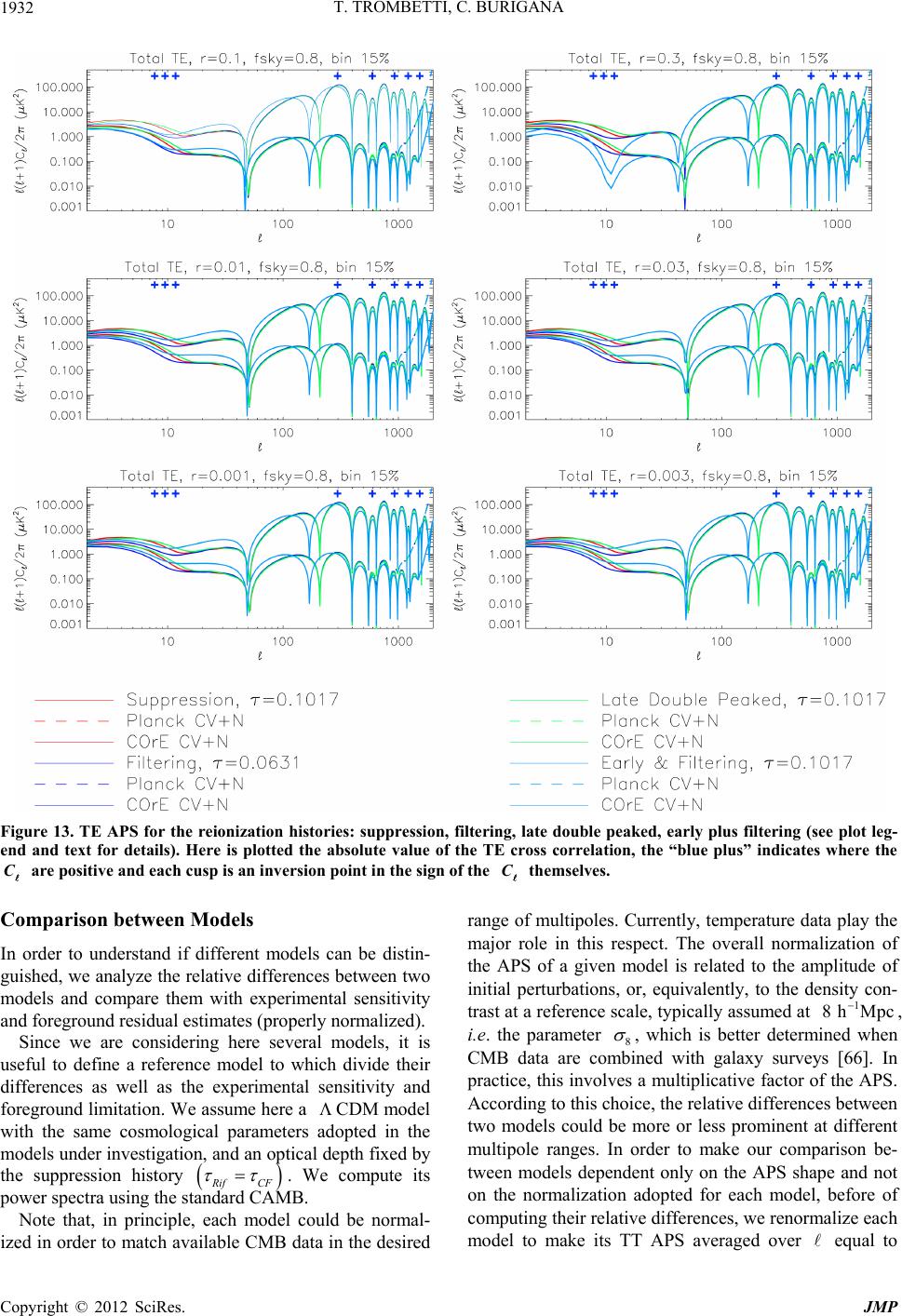 T. TROMBETTI, C. BURIGANA 1932 Figure 13. TE APS for the reionization histories: suppression, filtering, late double peaked, early plus filtering (see plot leg- end and text for details). Here is plotted the absolute value of the TE cross correlation, the “blue plus” indicates where the are positive and each cusp is an inversion point in the sign of the themselves. CC Comparison between Models In order to understand if different models can be distin- guished, we analyze the relative differences between two models and compare them with experimental sensitivity and foreground residual estimates (properly normalized). Since we are considering here several models, it is useful to define a reference model to which divide their differences as well as the experimental sensitivity and foreground limitation. We assume here a CDM model with the same cosmological parameters adopted in the models under investigation, and an optical depth fixed by the suppression history ifCF . We compute its power spectra using the standard CAMB. 1 8h Mpc Note that, in principle, each model could be normal- ized in order to match available CMB data in the desired range of multipoles. Currently, temperature data play the major role in this respect. The overall normalization of the APS of a given model is related to the amplitude of initial perturbations, or, equivalently, to the density con- trast at a reference scale, typically assumed at , i.e. the parameter 8 , which is better determined when CMB data are combined with galaxy surveys [66]. In practice, this involves a multiplicative factor of the APS. According to this choice, the relative differences between two models could be more or less prominent at different multipole ranges. In order to make our comparison be- tween models dependent only on the APS shape and not on the normalization adopted for each model, before of computing their relative differences, we renormalize each model to make its TT APS averaged over equal to Copyright © 2012 SciRes. JMP 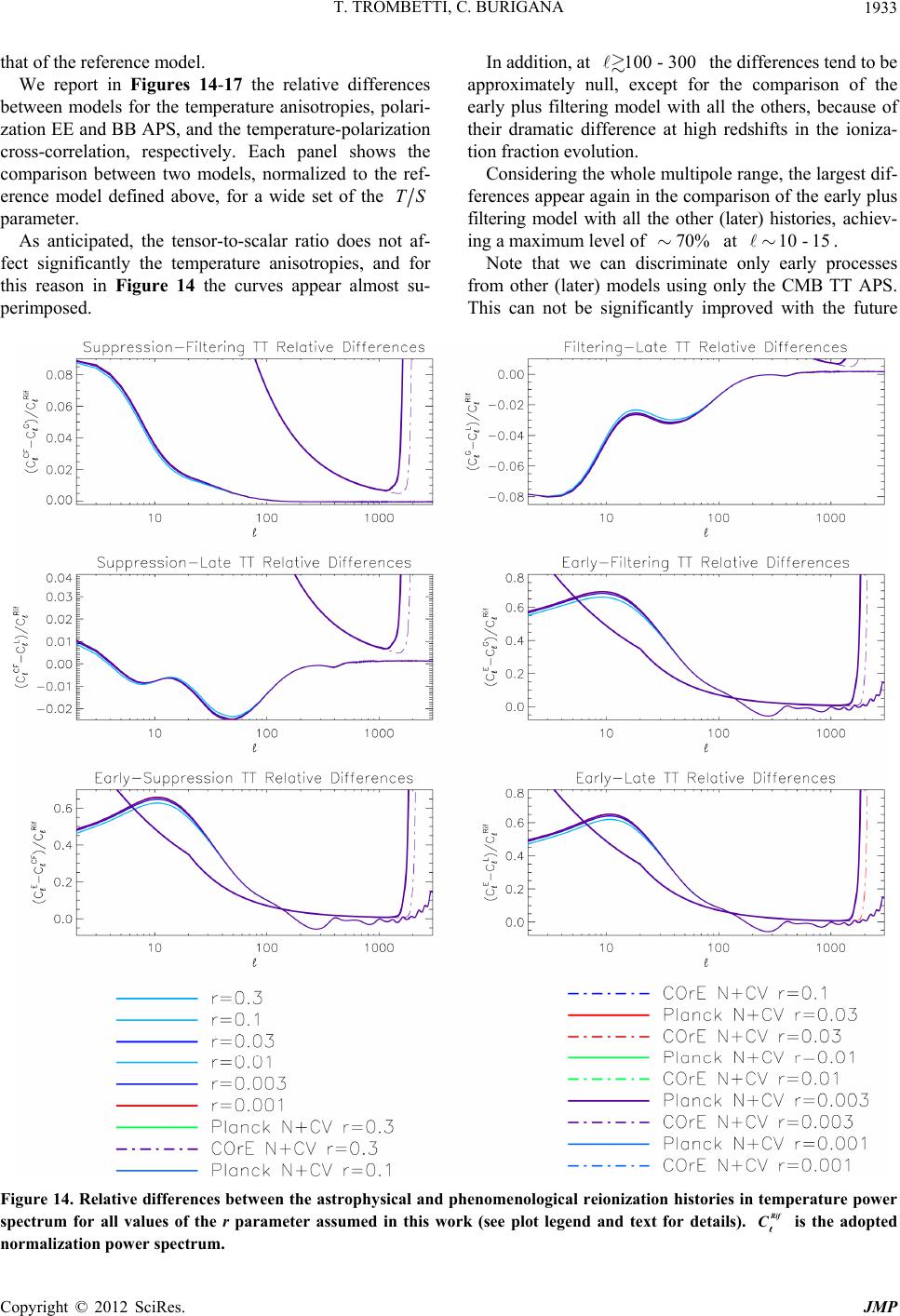 T. TROMBETTI, C. BURIGANA 1933 that of the reference model. We report in Figures 14-17 the relative differences between models for the temperature anisotropies, polari- zation EE and BB APS, and the temperature-polarization cross-correlation, respectively. Each panel shows the comparison between two models, normalized to the ref- erence model defined above, for a wide set of the TS 100 - 300 70%10 - 15 parameter. As anticipated, the tensor-to-scalar ratio does not af- fect significantly the temperature anisotropies, and for this reason in Figure 14 the curves appear almost su- perimposed. In addition, at the differences tend to be approximately null, except for the comparison of the early plus filtering model with all the others, because of their dramatic difference at high redshifts in the ioniza- tion fraction evolution. Considering the whole multipole range, the largest dif- ferences appear again in the comparison of the early plus filtering model with all the other (later) histories, achiev- ing a maximum level of at . Note that we can discriminate only early processes from other (later) models using only the CMB TT APS. This can not be significantly improved with the future Figure 14. Relative difference s between the astrophysic al and phenomenological reionization histories in temperature power spectrum for all values of the r parameter assumed in this work (see plot legend and text for details). i C is the adopted normalization power spectrum. Copyright © 2012 SciRes. JMP 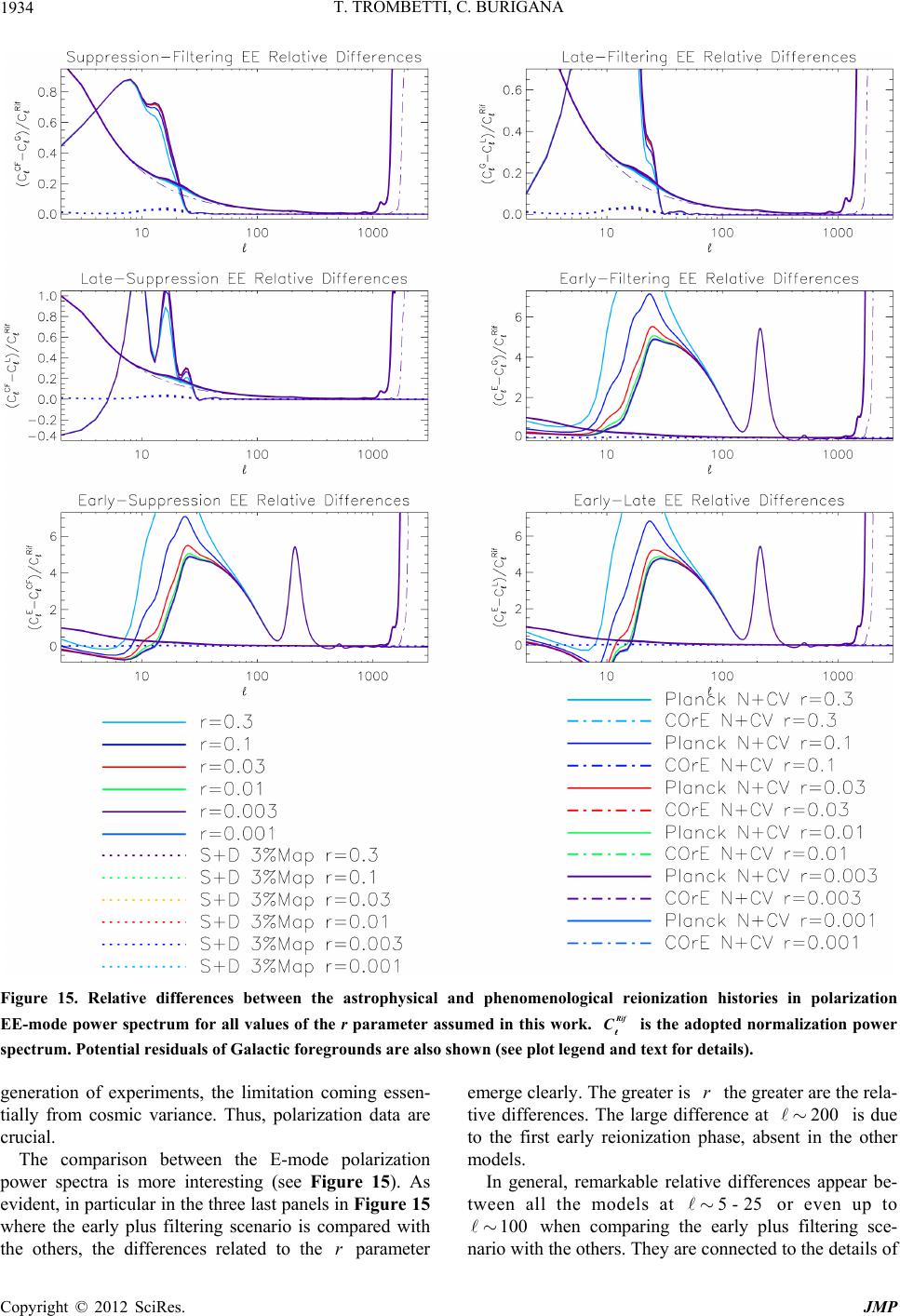 T. TROMBETTI, C. BURIGANA 1934 Figure 15. Relative differences between the astrophysical and phenomenological reionization histories in polarization EE-mode power spectrum for all values of the r parameter assumed in this work. i C r r 200 5 - 25 100 is the adopted normalization power spectrum. Potential residuals of Galactic fore gr ounds are also shown (see plot legend and te xt for details). generation of experiments, the limitation coming essen- tially from cosmic variance. Thus, polarization data are crucial. The comparison between the E-mode polarization power spectra is more interesting (see Figure 15). As evident, in particular in the three last panels in Figure 15 where the early plus filtering scenario is compared with the others, the differences related to the parameter emerge clearly. The greater is the greater are the rela- tive differences. The large difference at is due to the first early reionization phase, absent in the other models. In general, remarkable relative differences appear be- tween all the models at or even up to when comparing the early plus filtering sce- nario with the others. They are connected to the details of Copyright © 2012 SciRes. JMP 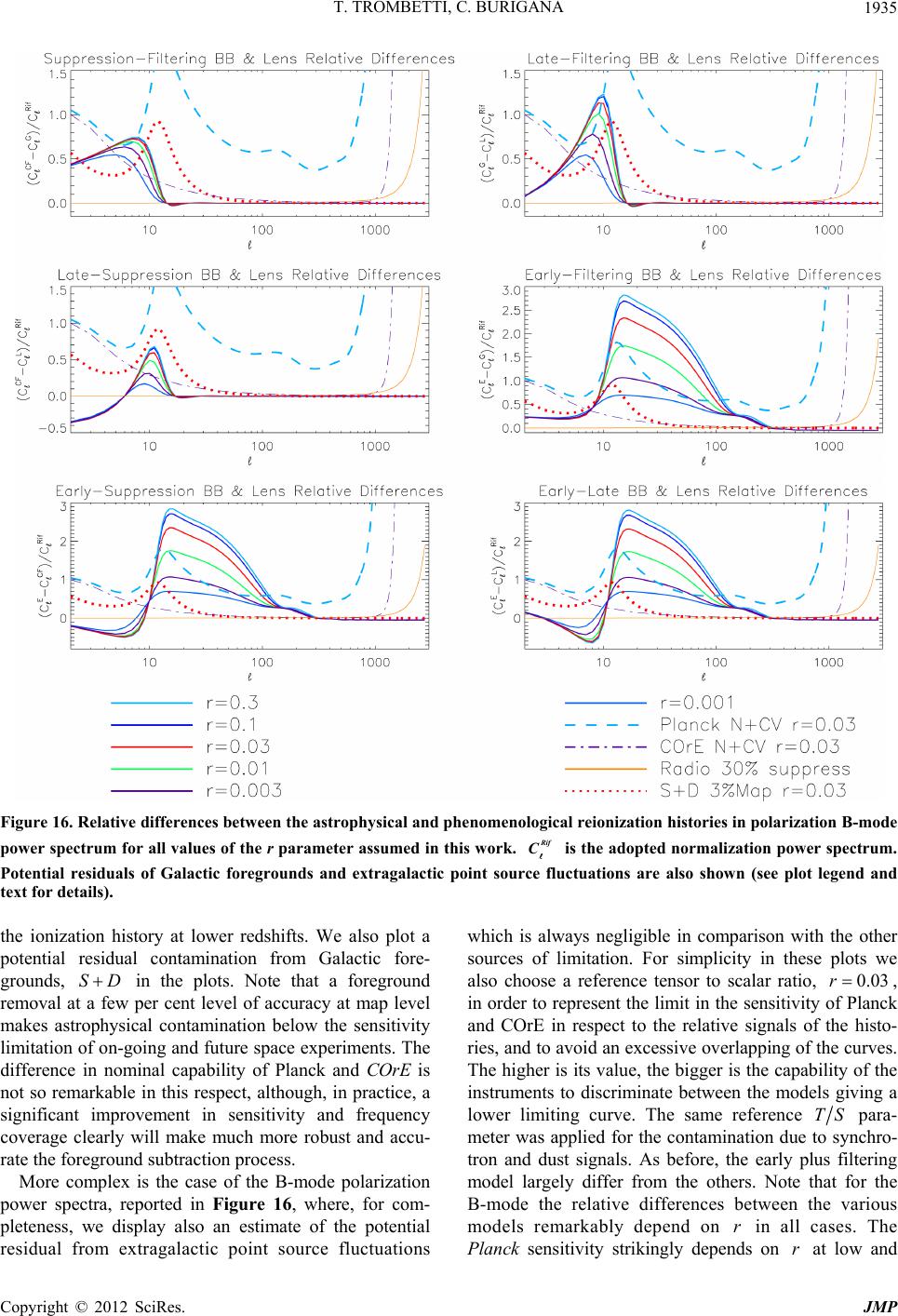 T. TROMBETTI, C. BURIGANA 1935 Figure 16. Relative differe nces betw een the astr ophysic al and phenomenologic al reionization histories in polarization B-mode power spectrum for all values of the r parameter assumed in this work. i C SD0.03r is the adopted normalization power spectrum. Potential residuals of Galactic foregrounds and extragalactic point source fluctuations are also shown (see plot legend and text for details). the ionization history at lower redshifts. We also plot a potential residual contamination from Galactic fore- grounds, in the plots. Note that a foreground removal at a few per cent level of accuracy at map level makes astrophysical contamination below the sensitivity limitation of on-going and future space experiments. The difference in nominal capability of Planck and COrE is not so remarkable in this respect, although, in practice, a significant improvement in sensitivity and frequency coverage clearly will make much more robust and accu- rate the foreground subtraction process. More complex is the case of the B-mode polarization power spectra, reported in Figure 16, where, for com- pleteness, we display also an estimate of the potential residual from extragalactic point source fluctuations which is always negligible in comparison with the other sources of limitation. For simplicity in these plots we also choose a reference tensor to scalar ratio, , in order to represent the limit in the sensitivity of Planck and COrE in respect to the relative signals of the histo- ries, and to avoid an excessive overlapping of the curves. The higher is its value, the bigger is the capability of the instruments to discriminate between the models giving a lower limiting curve. The same reference T para- meter was applied for the contamination due to synchro- tron and dust signals. As before, the early plus filtering model largely differ from the others. Note that for the B-mode the relative differences between the various models remarkably depend on in all cases. The Planck sensitivity strikingly depends on at low and S rr Copyright © 2012 SciRes. JMP 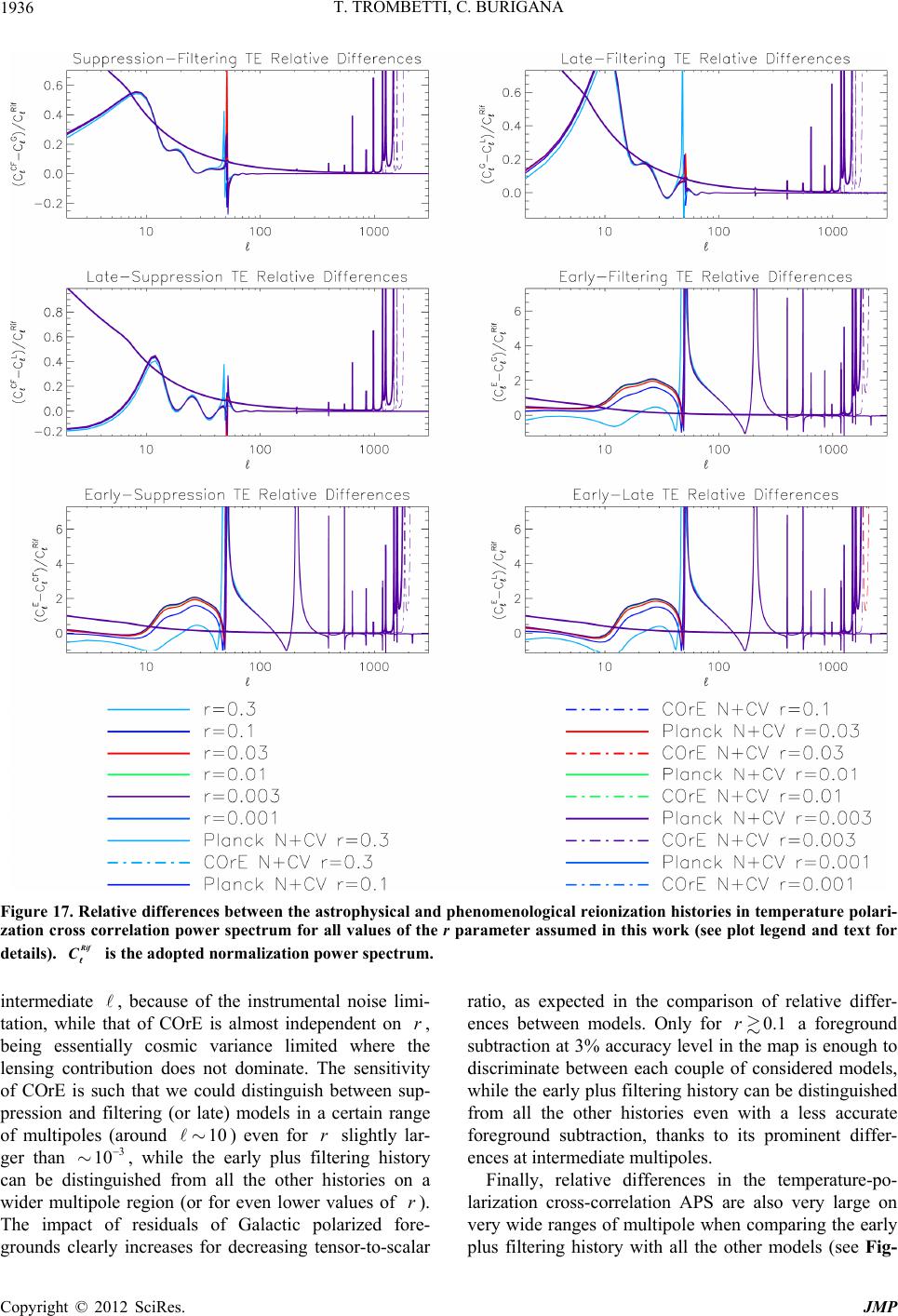 T. TROMBETTI, C. BURIGANA 1936 Figure 17. Relative differences between the astrophysical and phenomenological reionization histories in temperature polari- zation cross correlation power spectrum for all values of the r parameter assumed in this work (see plot legend and text for details). i C r 10 r 0.1r is the adopted normalization power spectrum. intermediate , because of the instrumental noise limi- tation, while that of COrE is almost independent on , being essentially cosmic variance limited where the lensing contribution does not dominate. The sensitivity of COrE is such that we could distinguish between sup- pression and filtering (or late) models in a certain range of multipoles (around ) even for slightly lar- ger than , while the early plus filtering history can be distinguished from all the other histories on a wider multipole region (or for even lower values of ). The impact of residuals of Galactic polarized fore- grounds clearly increases for decreasing tensor-to-scalar ratio, as expected in the comparison of relative differ- ences between models. Only for a foreground subtraction at 3% accuracy level in the map is enough to discriminate between each couple of considered models, while the early plus filtering history can be distinguished from all the other histories even with a less accurate foreground subtraction, thanks to its prominent differ- ences at intermediate multipoles. r 3 10 Finally, relative differences in the temperature-po- larization cross-correlation APS are also very large on very wide ranges of multipole when comparing the early plus filtering history with all the other models (see Fig- Copyright © 2012 SciRes. JMP  T. TROMBETTI, C. BURIGANA 1937 ure 17), filtering and late models show remarkable dif- ferences (larger than ) at low multipoles, while the suppression model differ from the late and filtering mod- els only on a very small range of multipoles around . The “spikes” appearing at high multipoles are due to little shifts of the multipoles corresponding to the change of sign of the cross-correlation spectra for the different considered models. The difference in nominal capability of Planck and COrE is not so remarkable for the TE mode. 80% 10 8. Conclusions The inclusion of astrophysically motivated ionization and thermal histories in numerical codes is crucial for the accurate prediction of the features induced in the CMB, for constraining reionization models with CMB data, and to exploit current and future high quality CMB data with great versatility to accurately extract cosmological in- formation. We have implemented a modified version of CAMB, the Cosmological Boltzmann code for computing the APS of the anisotropies of the CMB, to introduce the hydrogen and helium ionization fractions predicted in two astrophysical reionization models, i.e. suppression and filtering model, in two classes of phenomenological reionization histories, involving late or early reionization, and in their combination, as alternative to the original implementation of reionization in the CAMB code, and beyond the simple 9. Acknowledgements We acknowledge the use of the Legacy Archive for Mi- crowave Background Data Analysis (LAMBDA). Sup- port for LAMBDA is provided by the NASA Office of Space Science. We warmly thank Enrico Franceschi for his technical advices in TeX compilation. We acknowl- edge support by ASI through ASI/INAF Agreement I/072/09/0 for the Planck LFI Activity of Phase E2 and by MIUR through PRIN 2009 grant no. 2009XZ54H2. REFERENCES [1] P. J. E. Peebles, “Recombination of the Primeval Plasma,” The Astrophysical Journal, Vol. 153, 1968, p. 1. doi:10.1086/149628 [2] Ya. B. Zel’dovich, V. Kurt and R. A. Sunyaev, “Recom- bination of Hydrogen in the Hot Model of the Universe,” Zhurnal Eksperimental’noi i Teoreticheskoi Fiziki, Vol. 55, No. 1, 1968, pp. 278-286. [3] B. J. T. Jones and R. Wyse, “The Ionisation of the Pri- meval Plasma at the Time of Recombination,” Astronomy & Astrophysics, Vol. 149, No. 1, 1985, p. 144. [4] S. Seager, D. D. Sasselov and D. Scott, “How Exactly Did the Universe Become Neutral?” The Astrophysical Journal Supplement Series, Vol. 128, No. 2, 2000, pp. 407- 430, arXiv:astro-ph/9912182. doi:10.1086/313388 [5] N. A. Zabotin and P. D. Naselsky, “The Neutrino Back- ground in the Early Universe and Temperature Fluctua- tions in the Cosmic Microwave Radiation,” Soviet As- tronomy, Vol. 26, 1982, p. 272. -parametrization. For astrophysical models, we provide also suitable analytical descriptions of the ionization and thermal histories that can be in- gested in any numerical code aimed at computing CMB features. We compared the results obtained for these models for all the non-vanishing (in the assumed scenar- ios) modes of the CMB APS. As a significant step for- ward with respect to previous analyses, the emphasis has been posed here to the extension to a detailed characteri- zation of the polarization B-mode APS for these classes of models. Its amplitude and shape depends, in particular, on the tensor-to-scalar ratio, , and on the reionization history, thus an accurate modeling of the reionization process will have implications for the precise determina- tion of or to set more precise constraints on it through the joint analysis of E and B-mode polarization data available in the next future and from a mission of next generation. This is particularly crucial in the case of low values of , because of the contribution to B-mode coming from lensing that competes with the primordial B-mode at intermediate multipoles. Taking into account also the limitation from potential residuals of astrophysi- cal foregrounds, we discussed the capability of next data to disentangle between different reionization scenarios in a wide range of tensor-to-scalar ratios. [6] E. R. Switzer and C. M. Hirata, “Primordial Helium Re- combination. III. Thomson Scattering, Isotope Shifts, and Cumulative Results,” Physical Review D, Vol. 77, No. 8, 2008, 3008, arXiv:astro-ph/0702145. doi:10.1103/PhysRevD.77.083008 [7] A. A. Starobinsky, “Spectrum of Relict Gravitational Ra- diation and the Early State of the Universe,” Journal of Experimental and Theoretical Physics Letters, Vol. 30, No. 11, 1979, pp. 682-685. [8] L. F. Abbott and M. B. Wise, “Constraints on General- ized Inflationary Cosmologies,” Nuclear Physics B, Vol. 244, No. 2, 1984, pp. 541-548. doi:10.1016/0550-3213(84)90329-8 r r r [9] A. R. Liddle and D. H. Lyth, “COBE, Gravitational Waves, Inflation and Extended Inflation,” Physics Letters B, Vol. 291, 1992, pp. 391-398, arXiv:astro-ph/9208007. doi:10.1016/0370-2693(92)91393-N [10] A. R. Liddle and D. H. Lyth, “The Cold Dark Matter Den- sity Perturbations,” Physics Reports, Vol. 231, No. 1-2, 1993, pp. 1-105, arXiv:astro-ph/9303019. doi:10.1016/0370-1573(93)90114-S [11] S. Dodelson, “Modern Cosmology,” Academic Press, San Francisco, 2003. [12] D. N. Spergel, et al., “Three-Year Wilkinson Microwave Anisotropy Probe (WMAP) Observations: Implications for Cosmology,” The Astrophysical Journal Supplement Copyright © 2012 SciRes. JMP 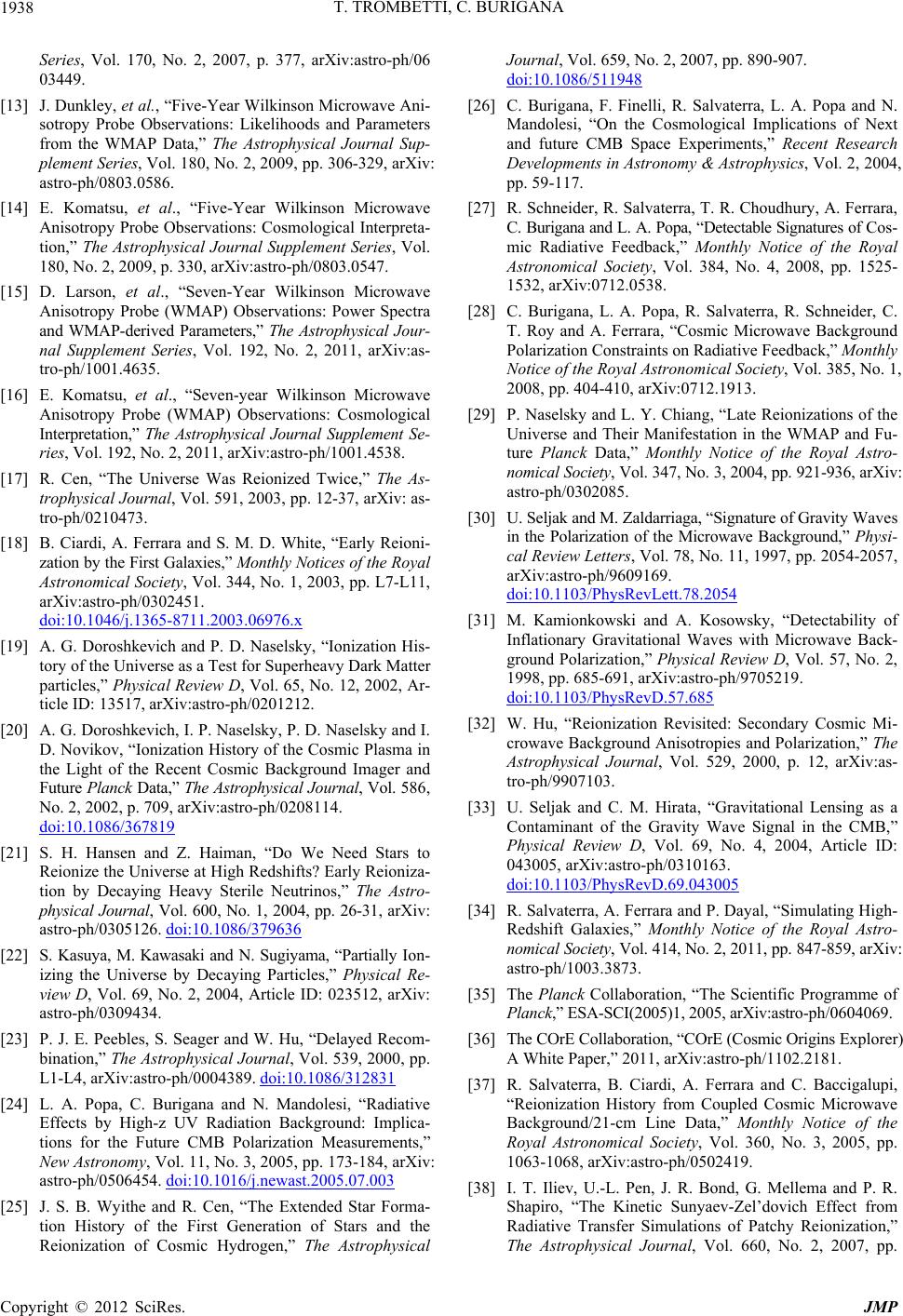 T. TROMBETTI, C. BURIGANA 1938 Series, Vol. 170, No. 2, 2007, p. 377, arXiv:astro-ph/06 03449. [13] J. Dunkley, et al., “Five-Year Wilkinson Microwave Ani- sotropy Probe Observations: Likelihoods and Parameters from the WMAP Data,” The Astrophysical Journal Sup- plement Series, Vol. 180, No. 2, 2009, pp. 306-329, arXiv: astro-ph/0803.0586. [14] E. Komatsu, et al., “Five-Year Wilkinson Microwave Anisotropy Probe Observations: Cosmological Interpreta- tion,” The Astrophysical Journal Supplement Series, Vol. 180, No. 2, 2009, p. 330, arXiv:astro-ph/0803.0547. [15] D. Larson, et al., “Seven-Year Wilkinson Microwave Anisotropy Probe (WMAP) Observations: Power Spectra and WMAP-derived Parameters,” The Astrophysical Jour- nal Supplement Series, Vol. 192, No. 2, 2011, arXiv:as- tro-ph/1001.4635. [16] E. Komatsu, et al., “Seven-year Wilkinson Microwave Anisotropy Probe (WMAP) Observations: Cosmological Interpretation,” The Astrophysical Journal Supplement Se- ries, Vol. 192, No. 2, 2011, arXiv:astro-ph/1001.4538. [17] R. Cen, “The Universe Was Reionized Twice,” The As- trophysical Journal, Vol. 591, 2003, pp. 12-37, arXiv: as- tro-ph/0210473. [18] B. Ciardi, A. Ferrara and S. M. D. White, “Early Reioni- zation by the First Galaxies,” Monthly Not ices of the R oy al Astronomical Society, Vol. 344, No. 1, 2003, pp. L7-L11, arXiv:astro-ph/0302451. doi:10.1046/j.1365-8711.2003.06976.x [19] A. G. Doroshkevich and P. D. Naselsky, “Ionization His- tory of the Universe as a Test for Superheavy Dark Matter particles,” Physical Review D, Vol. 65, No. 12, 2002, Ar- ticle ID: 13517, arXiv:astro-ph/0201212. [20] A. G. Doroshkevich, I. P. Naselsky, P. D. Naselsky and I. D. Novikov, “Ionization History of the Cosmic Plasma in the Light of the Recent Cosmic Background Imager and Future Planck Data,” The Astrophysical Journal, Vol. 586, No. 2, 2002, p. 709, arXiv:astro-ph/0208114. doi:10.1086/367819 [21] S. H. Hansen and Z. Haiman, “Do We Need Stars to Reionize the Universe at High Redshifts? Early Reioniza- tion by Decaying Heavy Sterile Neutrinos,” The Astro- physical Journal, Vol. 600, No. 1, 2004, pp. 26-31, arXiv: astro-ph/0305126. doi:10.1086/379636 [22] S. Kasuya, M. Kawasaki and N. Sugiyama, “Partially Ion- izing the Universe by Decaying Particles,” Physical Re- view D, Vol. 69, No. 2, 2004, Article ID: 023512, arXiv: astro-ph/0309434. [23] P. J. E. Peebles, S. Seager and W. Hu, “Delayed Recom- bination,” The Astrophysical Journal, Vol. 539, 2000, pp. L1-L4, arXiv:astro-ph/0004389. doi:10.1086/312831 [24] L. A. Popa, C. Burigana and N. Mandolesi, “Radiative Effects by High-z UV Radiation Background: Implica- tions for the Future CMB Polarization Measurements,” New Astronomy, Vol. 11, No. 3, 2005, pp. 173-184, arXiv: astro-ph/0506454. doi:10.1016/j.newast.2005.07.003 [25] J. S. B. Wyithe and R. Cen, “The Extended Star Forma- tion History of the First Generation of Stars and the Reionization of Cosmic Hydrogen,” The Astrophysical Journal, Vol. 659, No. 2, 2007, pp. 890-907. doi:10.1086/511948 [26] C. Burigana, F. Finelli, R. Salvaterra, L. A. Popa and N. Mandolesi, “On the Cosmological Implications of Next and future CMB Space Experiments,” Recent Research Developments in Astronomy & Astrophysics, Vol. 2, 2004, pp. 59-117. [27] R. Schneider, R. Salvaterra, T. R. Choudhury, A. Ferrara, C. Burigana and L. A. Popa, “Detectable Signatures of Cos- mic Radiative Feedback,” Monthly Notice of the Royal Astronomical Society, Vol. 384, No. 4, 2008, pp. 1525- 1532, arXiv:0712.0538. [28] C. Burigana, L. A. Popa, R. Salvaterra, R. Schneider, C. T. Roy and A. Ferrara, “Cosmic Microwave Background Polarization Constraints on Radiative Feedback,” Monthly Notice of the Royal Astronomical Society, Vol. 385, No. 1, 2008, pp. 404-410, arXiv:0712.1913. [29] P. Naselsky and L. Y. Chiang, “Late Reionizations of the Universe and Their Manifestation in the WMAP and Fu- ture Planck Data,” Monthly Notice of the Royal Astro- nomical Society, Vol. 347, No. 3, 2004, pp. 921-936, arXiv: astro-ph/0302085. [30] U. Seljak and M. Zaldarriaga, “Signature of Gravity Waves in the Polarization of the Microwave Background,” Physi- cal Review Letters, Vol. 78, No. 11, 1997, pp. 2054-2057, arXiv:astro-ph/9609169. doi:10.1103/PhysRevLett.78.2054 [31] M. Kamionkowski and A. Kosowsky, “Detectability of Inflationary Gravitational Waves with Microwave Back- ground Polarization,” Physical Review D, Vol. 57, No. 2, 1998, pp. 685-691, arXiv:astro-ph/9705219. doi:10.1103/PhysRevD.57.685 [32] W. Hu, “Reionization Revisited: Secondary Cosmic Mi- crowave Background Anisotropies and Polarization,” The Astrophysical Journal, Vol. 529, 2000, p. 12, arXiv:as- tro-ph/9907103. [33] U. Seljak and C. M. Hirata, “Gravitational Lensing as a Contaminant of the Gravity Wave Signal in the CMB,” Physical Review D, Vol. 69, No. 4, 2004, Article ID: 043005, arXiv:astro-ph/0310163. doi:10.1103/PhysRevD.69.043005 [34] R. Salvaterra, A. Ferrara and P. Dayal, “Simulating High- Redshift Galaxies,” Monthly Notice of the Royal Astro- nomical Society, Vol. 414, No. 2, 2011, pp. 847-859, arXiv: astro-ph/1003.3873. [35] The Planck Collaboration, “The Scientific Programme of Planck,” ESA-SCI(2005)1, 2005, arXiv:astro-ph/0604069. [36] The COrE Collaboration, “COrE (Cosmic Origins Explorer) A White Paper,” 2011, arXiv:astro-ph/1102.2181. [37] R. Salvaterra, B. Ciardi, A. Ferrara and C. Baccigalupi, “Reionization History from Coupled Cosmic Microwave Background/21-cm Line Data,” Monthly Notice of the Royal Astronomical Society, Vol. 360, No. 3, 2005, pp. 1063-1068, arXiv:astro-ph/0502419. [38] I. T. Iliev, U.-L. Pen, J. R. Bond, G. Mellema and P. R. Shapiro, “The Kinetic Sunyaev-Zel’dovich Effect from Radiative Transfer Simulations of Patchy Reionization,” The Astrophysical Journal, Vol. 660, No. 2, 2007, pp. Copyright © 2012 SciRes. JMP 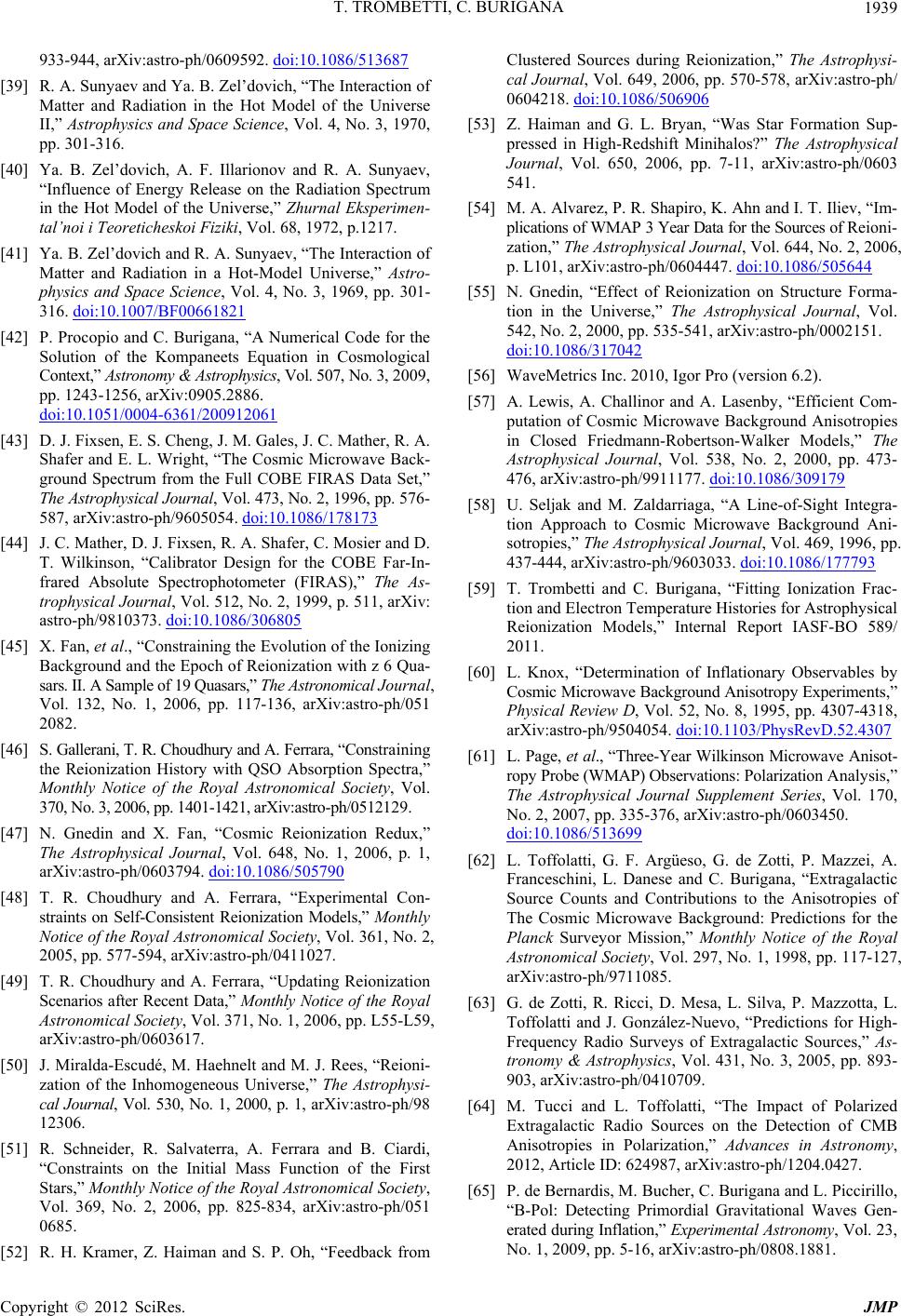 T. TROMBETTI, C. BURIGANA 1939 933-944, arXiv:astro-ph/0609592. doi:10.1086/513687 [39] R. A. Sunyaev and Ya. B. Zel’dovich, “The Interaction of Matter and Radiation in the Hot Model of the Universe II,” Astrophysics and Space Science, Vol. 4, No. 3, 1970, pp. 301-316. [40] Ya. B. Zel’dovich, A. F. Illarionov and R. A. Sunyaev, “Influence of Energy Release on the Radiation Spectrum in the Hot Model of the Universe,” Zhurnal Eksperimen- tal’noi i Teoreticheskoi Fiziki, Vol. 68, 1972, p.1217. [41] Ya. B. Zel’dovich and R. A. Sunyaev, “The Interaction of Matter and Radiation in a Hot-Model Universe,” Astro- physics and Space Science, Vol. 4, No. 3, 1969, pp. 301- 316. doi:10.1007/BF00661821 [42] P. Procopio and C. Burigana, “A Numerical Code for the Solution of the Kompaneets Equation in Cosmological Context,” Astronomy & Astrophysics, Vol. 507, No. 3, 2009, pp. 1243-1256, arXiv:0905.2886. doi:10.1051/0004-6361/200912061 [43] D. J. Fixsen, E. S. Cheng, J. M. Gales, J. C. Mather, R. A. Shafer and E. L. Wright, “The Cosmic Microwave Back- ground Spectrum from the Full COBE FIRAS Data Set,” The Astrophysical Journal, Vol. 473, No. 2, 1996, pp. 576- 587, arXiv:astro-ph/9605054. doi:10.1086/178173 [44] J. C. Mather, D. J. Fixsen, R. A. Shafer, C. Mosier and D. T. Wilkinson, “Calibrator Design for the COBE Far-In- frared Absolute Spectrophotometer (FIRAS),” The As- trophysical Journal, Vol. 512, No. 2, 1999, p. 511, arXiv: astro-ph/9810373. doi:10.1086/306805 [45] X. Fan, et al., “Constraining the Evolution of the Ionizing Background and the Epoch of Reionization with z 6 Qua- sars. II. A Sample of 19 Quasars,” The Astronomical Journal, Vol. 132, No. 1, 2006, pp. 117-136, arXiv:astro-ph/051 2082. [46] S. Gallerani, T. R. Choudhury and A. Ferrara, “Constraining the Reionization History with QSO Absorption Spectra,” Monthly Notice of the Royal Astronomical Society, Vol. 370, No. 3, 2006, pp. 1401-1421, arXiv:astro-ph/0512129. [47] N. Gnedin and X. Fan, “Cosmic Reionization Redux,” The Astrophysical Journal, Vol. 648, No. 1, 2006, p. 1, arXiv:astro-ph/0603794. doi:10.1086/505790 [48] T. R. Choudhury and A. Ferrara, “Experimental Con- straints on Self-Consistent Reionization Models,” Monthly Notice of the Royal Astronomical Society, Vol. 361, No. 2, 2005, pp. 577-594, arXiv:astro-ph/0411027. [49] T. R. Choudhury and A. Ferrara, “Updating Reionization Scenarios after Recent Data,” Monthly Notice of the R oyal Astronomical Society, Vol. 371, No. 1, 2006, pp. L55-L59, arXiv:astro-ph/0603617. [50] J. Miralda-Escudé, M. Haehnelt and M. J. Rees, “Reioni- zation of the Inhomogeneous Universe,” The Astrophysi- cal Journal, Vol. 530, No. 1, 2000, p. 1, arXiv:astro-ph/98 12306. [51] R. Schneider, R. Salvaterra, A. Ferrara and B. Ciardi, “Constraints on the Initial Mass Function of the First Stars,” Monthly Notice of the Royal Astronomical Society, Vol. 369, No. 2, 2006, pp. 825-834, arXiv:astro-ph/051 0685. [52] R. H. Kramer, Z. Haiman and S. P. Oh, “Feedback from Clustered Sources during Reionization,” The Astrophysi- cal Journal, Vol. 649, 2006, pp. 570-578, arXiv:astro-ph/ 0604218. doi:10.1086/506906 [53] Z. Haiman and G. L. Bryan, “Was Star Formation Sup- pressed in High-Redshift Minihalos?” The Astrophysical Journal, Vol. 650, 2006, pp. 7-11, arXiv:astro-ph/0603 541. [54] M. A. Alvarez, P. R. Shapiro, K. Ahn and I. T. Iliev, “Im- plications of WMAP 3 Year Data for the Sources of Reioni- zation,” The Astrophysical Journal, Vol. 644, No. 2, 2006, p. L101, arXiv:astro-ph/0604447. doi:10.1086/505644 [55] N. Gnedin, “Effect of Reionization on Structure Forma- tion in the Universe,” The Astrophysical Journal, Vol. 542, No. 2, 2000, pp. 535-541, arXiv:astro-ph/0002151. doi:10.1086/317042 [56] WaveMetrics Inc. 2010, Igor Pro (version 6.2). [57] A. Lewis, A. Challinor and A. Lasenby, “Efficient Com- putation of Cosmic Microwave Background Anisotropies in Closed Friedmann-Robertson-Walker Models,” The Astrophysical Journal, Vol. 538, No. 2, 2000, pp. 473- 476, arXiv:astro-ph/9911177. doi:10.1086/309179 [58] U. Seljak and M. Zaldarriaga, “A Line-of-Sight Integra- tion Approach to Cosmic Microwave Background Ani- sotropies,” The Astrophysical Journal, Vol. 469, 1996, pp. 437-444, arXiv:astro-ph/9603033. doi:10.1086/177793 [59] T. Trombetti and C. Burigana, “Fitting Ionization Frac- tion and Electron Temperature Histories for Astrophysical Reionization Models,” Internal Report IASF-BO 589/ 2011. [60] L. Knox, “Determination of Inflationary Observables by Cosmic Microwave Background Anisotropy Experiments,” Physical Review D, Vol. 52, No. 8, 1995, pp. 4307-4318, arXiv:astro-ph/9504054. doi:10.1103/PhysRevD.52.4307 [61] L. Page, et al., “Three-Year Wilkinson Microwave Anisot- ropy Probe (WMAP) Observations: Polarization Analysis,” The Astrophysical Journal Supplement Series, Vol. 170, No. 2, 2007, pp. 335-376, arXiv:astro-ph/0603450. doi:10.1086/513699 [62] L. Toffolatti, G. F. Argüeso, G. de Zotti, P. Mazzei, A. Franceschini, L. Danese and C. Burigana, “Extragalactic Source Counts and Contributions to the Anisotropies of The Cosmic Microwave Background: Predictions for the Planck Surveyor Mission,” Monthly Notice of the Royal Astronomical Society, Vol. 297, No. 1, 1998, pp. 117-127, arXiv:astro-ph/9711085. [63] G. de Zotti, R. Ricci, D. Mesa, L. Silva, P. Mazzotta, L. Toffolatti and J. González-Nuevo, “Predictions for High- Frequency Radio Surveys of Extragalactic Sources,” As- tronomy & Astrophysics, Vol. 431, No. 3, 2005, pp. 893- 903, arXiv:astro-ph/0410709. [64] M. Tucci and L. Toffolatti, “The Impact of Polarized Extragalactic Radio Sources on the Detection of CMB Anisotropies in Polarization,” Advances in Astronomy, 2012, Article ID: 624987, arXiv:astro-ph/1204.0427. [65] P. de Bernardis, M. Bucher, C. Burigana and L. Piccirillo, “B-Pol: Detecting Primordial Gravitational Waves Gen- erated during Inflation,” Experimental Astronomy, Vol. 23, No. 1, 2009, pp. 5-16, arXiv:astro-ph/0808.1881. Copyright © 2012 SciRes. JMP 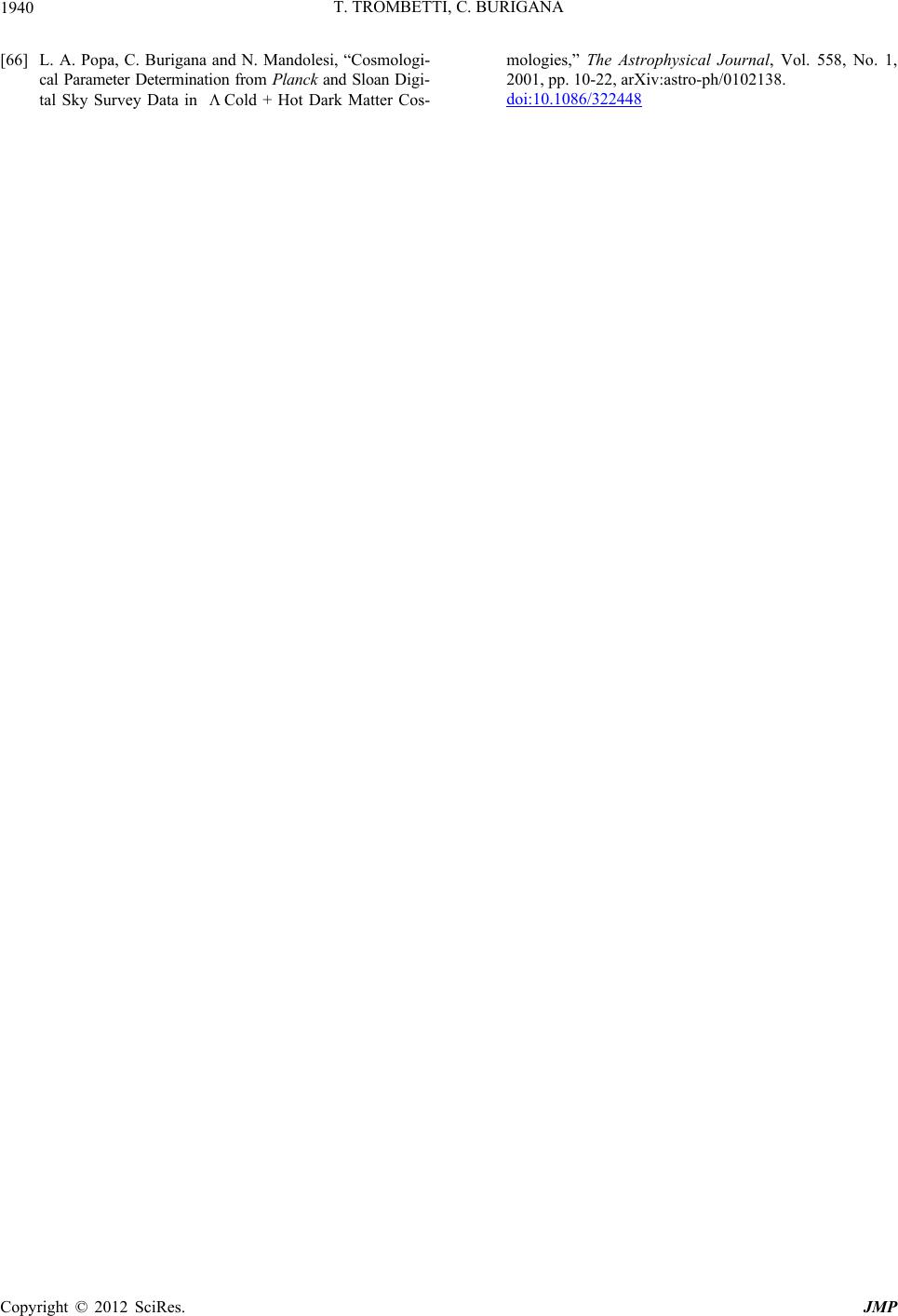 T. TROMBETTI, C. BURIGANA Copyright © 2012 SciRes. JMP 1940 [66] L. A. Popa, C. Burigana and N. Mandolesi, “Cosmologi- cal Parameter Determination from Planck and Sloan Digi- tal Sky Survey Data in Cold + Hot Dark Matter Cos- mologies,” The Astrophysical Journal, Vol. 558, No. 1, 2001, pp. 10-22, arXiv:astro-ph/0102138. doi:10.1086/322448 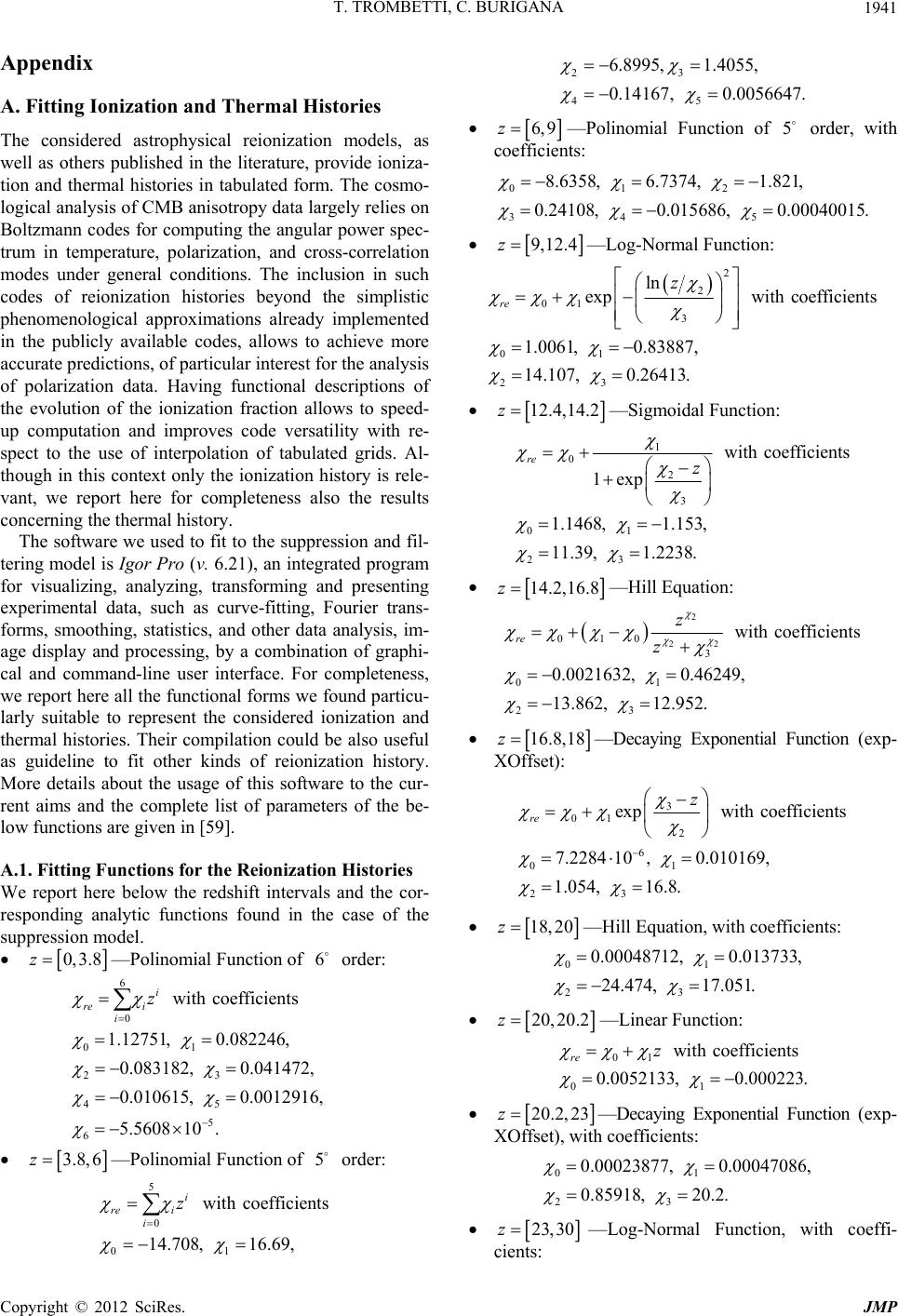 T. TROMBETTI, C. BURIGANA 1941 Appendix A. Fitting Ionization and Thermal Histories The considered astrophysical reionization models, as well as others published in the literature, provide ioniza- tion and thermal histories in tabulated form. The cosmo- logical analysis of CMB anisotropy data largely relies on Boltzmann codes for computing the angular power spec- trum in temperature, polarization, and cross-correlation modes under general conditions. The inclusion in such codes of reionization histories beyond the simplistic phenomenological approximations already implemented in the publicly available codes, allows to achieve more accurate predictions, of particular interest for the analysis of polarization data. Having functional descriptions of the evolution of the ionization fraction allows to speed- up computation and improves code versatility with re- spect to the use of interpolation of tabulated grids. Al- though in this context only the ionization history is rele- vant, we report here for completeness also the results concerning the thermal history. The software we used to fit to the suppression and fil- tering model is Igor Pro (v. 6.21), an integrated program for visualizing, analyzing, transforming and presenting experimental data, such as curve-fitting, Fourier trans- forms, smoothing, statistics, and other data analysis, im- age display and processing, by a combination of graphi- cal and command-line user interface. For completeness, we report here all the functional forms we found particu- larly suitable to represent the considered ionization and thermal histories. Their compilation could be also useful as guideline to fit other kinds of reionization history. More details about the usage of this software to the cur- rent aims and the complete list of parameters of the be- low functions are given in [59]. A.1. Fitting Functions for the Reionization Histories We report here below the redshift intervals and the cor- responding analytic functions found in the case of the suppression model. 0, 3.8—Polinomial Function of 6 order: z 3 ficien t s .082246, 0.041472, 0.0012916, 6 0 01 2 45 5 6 with coef 1.12751, 0 0.083182, 0.010615, 5.5608 10 . i re i i z 3.8,6 —Polinomial Function of 5 order: z 5 0 01 with 14.708, i re i i z coefficients 16.69, 23 45 6.8995, 1.4055, 0.14167, 0.0056647. 6,9z—Polinomial Function of 5 order, with coefficients: 012 34 5 8.6358, 6.7374,1.821, 0.24108,0.015686, 0.00040015. 9, 1 2.4—Log-Normal Function: z 2 2 01 3 01 23 ln expwithcoefficients 1.0061, 0.83887, 14.107, 0.26413. re z 12.4,14.2 —Sigmoidal Function: z 1 0 2 3 01 23 with coefficients 1exp 1.1468, 1.153, 11.39,1.2238. re z 14.2,16.8 —Hill Equation: z 2 22 010 3 01 23 withcoefficients 0.0021632, 0.46249, 13.862, 12.952. re z z 16.8,18 —Decaying Exponential Function (exp- XOffset): z 3 01 2 6 01 23 expwith coefficients 7.2284 10,0.010169, 1.054, 16.8. re z 18, 20—Hill Equation, with coefficients: z 01 23 0.00048712, 0.013733, 24.474, 17.051. 20,20.2—Linear Function: z 01 01 with coefficients 0.0052133, 0.000223. re z 20.2, 23—Decaying Exponential Function (exp- XOffset), with coefficients: z 01 23 0.00023877, 0.00047086, 0.85918, 20.2. 23,30—Log-Normal Function, with coeffi- cients: z Copyright © 2012 SciRes. JMP  T. TROMBETTI, C. BURIGANA 1942 6 .6891 10, 01 23 0.00025689, 9 25.421, 0.10111. We report here below the redshift intervals and the corresponding analytic functions found in the case of the filtering model. 0, 3.8—Polinomial Function of 9 order: z 5 ients 5, 489, 856, 045895, 1.4397 10. 9 0 01 23 45 67 89 withcoeffic 1.1245, 0.1049 0.19535,0.25 0.20598,0.098 0.028032, 0.0 0.00040036, i re i i z 3.8,6—Log-Normal Function, with coefficients: z 0.7941, 1.7469. 01 23 1.8818, 6.3915, 6, 6.2—Linear Function, with coefficients: z 1 0.1981. 0 2.2768, 6.2,9—Hill Equation, with coefficients: z 01 23 2.7323, 5.6876. 0.1805, 3.6558, 9, 1 1.6—Sigmoidal Function, with coefficients: z 1.1441, 1.4126. 01 23 1.1438, 7.3904, 11.6,13 —Power Function: z 6 1 efficients .052910 , 2 01 0 2 withco 0.0089383, 2 7.0525. re z 13,15—Power Function, with coefficients: z 2 9.5468. 8 01 0.0015104,9.163710 , 15,17—Decaying Exponential Function (exp- XOffset), with coefficients: z 0.003812, 01 23 0.00013226, 1.1503,15. 17,19.6 —Decaying Exponential Function (exp- XOffset), with coefficients: z 1 .00057014, 0 23 0.00023759, 0 0.98278, 17. 19 5 1 .6107 10, .6, 22.2—Decaying Exponential Function (exp- XOffset), with coefficients: z 0 23 0.00023514, 4 1.3061, 19.6. 22.2,30 —Decaying Exponential Function (exp- XOffset), with coefficients: z 01 23 0.052228, 0.051987, 26607, 22.2. A.2. Fitting Functi ons fo r the Temperature Histories We report here below the redshift intervals and the cor- responding analytic functions found in the case of the suppression model. 0,3 . 8—Polinomial Function of 8 order: z 8 0 01 2 345 67 8 withcoefficients 3870, 6793.7,7221.8, 15962, 13644,6419.7, 1734.7,252.65,15.379. i re i i TTz TT T TTT TT T 3.8,5.8 —Sigmoidal Function: z 1 0 2 3 01 23 withcoefficients 1exp 20934, 8982.3, 4.0373, 0.45319. re T TT Tz T TT TT 5.8,13—Hill Eqation: z 2 22 010 3 01 23 with coefficients 204.2,12105, 10.529,11.612. T re TT z TTTT zT TT TT 13,16—Hill Equation, with coefficients: z 01 23 60.289, 8498.4, 12.484,12.23. TT TT 16,16.8 —Decaying Exponential Function (exp- XOffset): z 3 01 2 0123 expwith coefficients 0.78206, 229.94,1.0994,16. re Tz TTT T TTTT 16.8,18.6 —Hill Equation, with coefficients: z 01 23 11.543,705.41, 19.532,15.338. TT TT 18.6, 20.2—Log-Normal Function: z 2 2 01 3 01 23 ln expwith coefficients 16.488,34.915, 17.003,0.082807. re zT TTT T TTTT 20.2, 21—Sigmoidal Function, with coefficients: z 01 23 23.26, 8.5661, 19.785, 0.41168. TT TT 21, 22—Log-Normal Function, with coefficients: z Copyright © 2012 SciRes. JMP 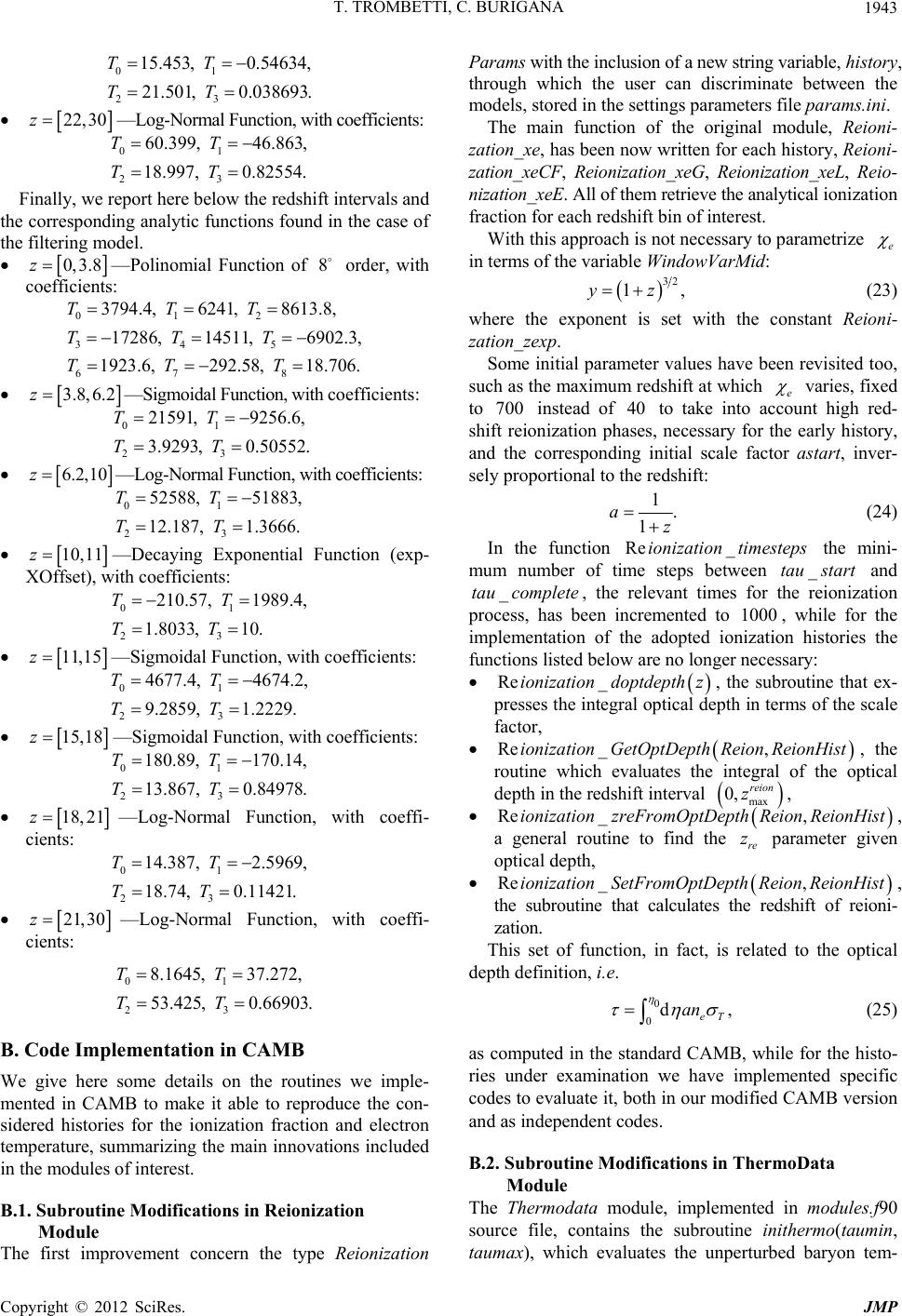 T. TROMBETTI, C. BURIGANA 1943 01 23 15.453, 21.501, TT TT 0.54634, 0.038693. 22,30—Log-Normal Function, with coefficients: z 46.863, 0.82554. 01 23 60.399, 18.997, TT TT Finally, we report here below the redshift intervals and the corresponding analytic functions found in the case of the filtering model. 0, 3.8—Polinomial Function of 8 order, with coefficients: z 2 5 8 8613.8, 6902.3, 18.706. T T T 01 34 67 3794.4, 6241, 17286, 14511, 1923.6, 292.58, TT TT TT 3.8,6.2—Sigmoidal Function, with coefficients: z 23 9256.6, 0.50552. 01 21591, 3.9293, TT TT 6.2,10—Log-Normal Function, with coefficients: z 23 51883, 1.3666. 01 52588, 12.187, TT TT 10,11—Decaying Exponential Function (exp- XOffset), with coefficients: z 01 1989.4, 10. T 23 210.57, 1.8033, T TT 11, 15—Sigmoidal Function, with coefficients: z 4674.2, 1.2229. 01 23 4677.4, 9.2859, TT TT 15,18—Sigmoidal Function, with coefficients: z 170.14, 0.84978. 01 23 180.89, 13.867, TT TT 18,21—Log-Normal Function, with coeffi- cients: z 2.5969, 0.11421. 01 23 14.387, 18.74, TT TT 21,30—Log-Normal Function, with coeffi- cients: z 01 23 37.272, 0.66903. e 8.1645, 53.425, TT TT B. Code Implementation in CAMB We give here some details on the routines we imple- mented in CAMB to make it able to reproduce the con- sidered histories for the ionization fraction and electron temperature, summarizing the main innovations included in the modules of interest. B.1. Subroutine Modifications in Reionization Module The first improvement concern the type Reionization Params with the inclusion of a new string variable, history, through which the user can discriminate between the models, stored in the settings parameters file params.ini. The main function of the original module, Reioni- zation_xe, has been now written for each history, Reioni- zation_xeCF, Reionization_xeG, Reionization_xeL, Reio- nization_xeE. All of them retrieve the analytical ionization fraction for each redshift bin of interest. With this approach is not necessary to parametrize in terms of the variable WindowVarMid: 32 1,yz (23) where the exponent is set with the constant Reioni- zation_zexp. Some initial parameter values have been revisited too, such as the maximum redshift at which e varies, fixed to instead of to take into account high red- shift reionization phases, necessary for the early history, and the corresponding initial scale factor astart, inver- sely proportional to the redshift: 700 40 1. 1 az (24) In the function the mini- mum number of time steps between Re _ionizationtimesteps ta and , the relevant times for the reionization process, has been incremented to 1000 , while for the implementation of the adopted ionization histories the functions listed below are no longer necessary: u start _tau complete Re _ionization dopt Re _,ionizationGetOptDepthReion R Re _,ionizationzreFromOptDepthReion R Re _,ionizationSetFromOptDepthReion R 0 0d, eT an depth z, the subroutine that ex- presses the integral optical depth in terms of the scale factor, eionHist , the routine which evaluates the integral of the optical depth in the redshift interval max 0, reion z, eionHist , a general routine to find the re z parameter given optical depth, eionHist , the subroutine that calculates the redshift of reioni- zation. This set of function, in fact, is related to the optical depth definition, i.e. (25) as computed in the standard CAMB, while for the histo- ries under examination we have implemented specific codes to evaluate it, both in our modified CAMB version and as independent codes. B.2. Subroutine Modifications in ThermoData Module The Thermodata module, implemented in modules.f90 source file, contains the subroutine inithermo(taumin, taumax), which evaluates the unperturbed baryon tem- Copyright © 2012 SciRes. JMP  T. TROMBETTI, C. BURIGANA Copyright © 2012 SciRes. JMP 1944 e perature and ionization fraction as function of time. If there is reionization, the function discriminates between the models, smoothly increases CAMB: Code for the Anisotropy Microwave Back- ground to the requested value and sets the to the value im- posed by the corresponding model. APS: Angular Power Spectrum __opt depthactualCF06: Suppression Reionization Model G00: Filtering Reionization Model CV: Cosmic Variance C. List of Acronyms SV: Sampling Variance IR: InfraRed CMB: Cosmic Microwave Background ACT: Atacama Cosmology Telescope COrE: Cosmic Origins Explorer ALMA: Atacama Large Millimeter/Submillimeter Array WMAP: Wilkinson Microwave Anisotropy Probe FWHM: Full Width Half Maximum IGM: Inter Galactic Medium HFI: HFI Frequency Instrument SDSS: Sloan Digital Sky Survey LFI: Low Frequency Instrument QSO: Quasar CDM: Cold Dark Matter IMF: Initial Mass Function
|